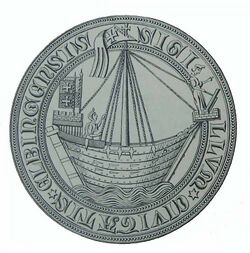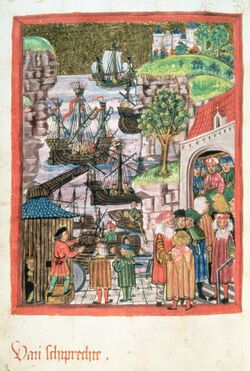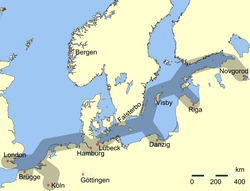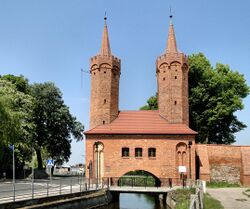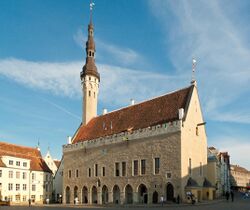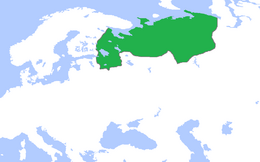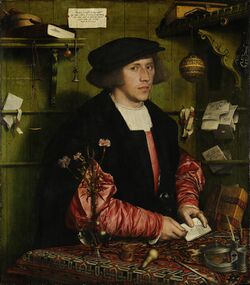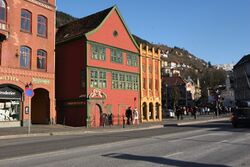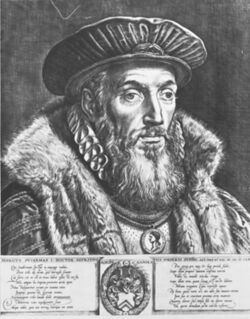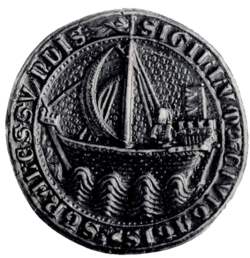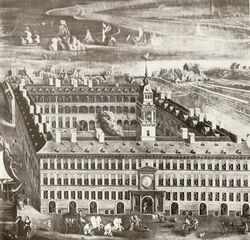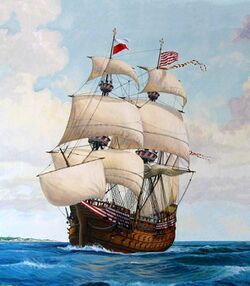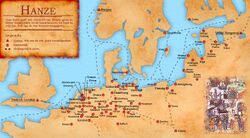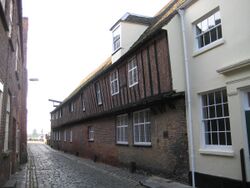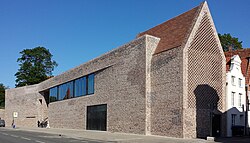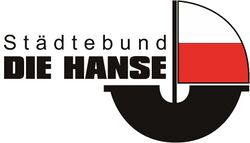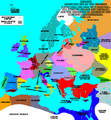Hanseatic League
Topic: Organization
 From HandWiki - Reading time: 55 min
From HandWiki - Reading time: 55 min
Hanseatic League Hanse Hansa | |
|---|---|
|
Hanseatic pennant | |
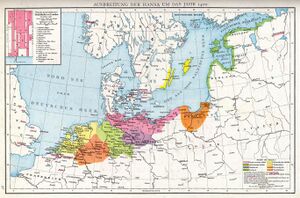 Northern Europe in the 1400s, showing the extent of the Hanseatic League | |
| Capital | Lübeck (Free City of) |
| Lingua franca | Middle Low German[1][2] |
| Membership | Various cities across the region of the Baltic and North Seas |
| Today part of |
|
The Hanseatic League[lower-alpha 1] was a medieval commercial and defensive confederation of merchant guilds and market towns in Central and Northern Europe. Growing from a few North German towns in the late 12th century, the League expanded between the 13th and 15th centuries and ultimately encompassed nearly 200 settlements across seven modern-day countries, ranging from Estonia in the north and east, to King's Lynn, England in the west,[4][5] and Kraków, Poland , in the south.[6]
The League originated from various loose associations of German traders and towns formed to advance mutual commercial interests, such as protection against robbers. These arrangements gradually coalesced into the Hanseatic League, whose traders enjoyed toll privileges and protection in affiliated communities and their trade routes. Economic interdependence and kinship ties between merchant families, who held important positions in towns, led to deeper political integration and the removal of obstacles to trade.[7] Hanseatic Cities gradually developed common trade regulations.
During its heyday, the Hanseatic League dominated maritime trade in the North and Baltic Seas. It established trading posts in numerous towns and cities across Europe; some of these, like the Kontors in London (the Steelyard), Bruges, Bergen, and Novgorod, became extraterritorial entities that enjoyed considerable legal autonomy. Hanseatic merchants, called Hansards, operated in basic private companies and were widely known for their access to a variety of commodities, and enjoyed privileges and protections abroad. The collective economic power made the League capable of imposing blockades and even waging war against kingdoms and principalities.
Even at its peak, the Hanseatic League was never more than a loosely aligned confederation of city-states. It lacked a permanent administrative body, a treasury, and a standing military force. In the 14th century, the Hanseatic League instated an irregular negotiating diet (Template:Lang-gml or dach; German: Tagfahrt or Hansetag) that operated on deliberation and consensus. By the mid-16th century, these weak connections left the Hanseatic League vulnerable, and it gradually unraveled as members became consolidated into other realms or departed, ultimately disintegrating in 1669.
The Hanseatic League used several types of ships that sailed over seas and on rivers. The most emblematic type was the cog. Knowing great diversity in construction, it was depicted on Hanseatic seals and coats of arms. By the end of the Middle Ages, the cog was replaced by other types like the hulk, which later gave way to larger carvel types.
Etymology
Hanse is the Old High German word for a band or troop.[8] This word was applied to bands of merchants traveling between the Hanseatic cities — whether by land or by sea.[9] Hanse in Middle Low German came to mean a society of merchants or a trader guild.[10] That it originally meant An-See, or "on the sea", is incorrect.[11](p145)
History
Exploratory trading adventures, raids, and piracy occurred early throughout the Baltic Sea. The sailors of Gotland sailed up rivers as far away as Novgorod,[12] which was a major trade centre of Rus'. Scandinavians led international trade in the Baltic area before the Hanseatic League, establishing major trading hubs at Birka, Haithabu, and Schleswig by the 9th century CE. The later Hanseatic ports between Mecklenburg and Königsberg (present-day Kaliningrad) originally formed part of the Scandinavian-led Baltic trade-system.[13]
The Hanseatic League was never formally founded, so it lacks a date of founding.[14](p2) Historians traditionally traced its origins to the rebuilding of the north German town of Lübeck in 1159 by the powerful Henry the Lion, Duke of Saxony and Bavaria, after he had captured the area from Adolf II, Count of Schauenburg and Holstein. More recent scholarship has deemphasized the focus on Lübeck, viewing it as one of several regional trading centers,[15] and presenting the League as the combination of a north German trading system oriented on the Baltic and a Rhinelandic trading system targeting England and Flanders.[7]
German cities achieved domination of trade in the Baltic with striking speed during the 13th century, and Lübeck became a central node in the seaborne trade that linked the areas around the North and Baltic seas. The hegemony of Lübeck peaked during the 15th century.[16]
Foundation and early development
Well before the term Hanse appeared in a document in 1267,[17] merchants in different cities began to form guilds, or hansas, with the intention of trading with towns overseas, especially in the economically less-developed eastern Baltic. This area could supply timber, wax, amber, resins, and furs, along with rye and wheat brought down on barges from the hinterland to port markets. Merchant guilds formed in both hometowns and destination ports as medieval corporations (universitates mercatorum),[18](pp42–43) and despite competition would increasingly cooperate to coalesce into the Hanseatic network of merchant guilds. The dominant language of trade was Middle Low German, which had significant impact on the languages spoken in the area, particularly the larger Scandinavian languages,[19](pp1222–1233)[20](pp1933–1934) Estonian,[21](p288) and Latvian.[22](pp230–231)
Lübeck soon became a base for merchants from Saxony and Westphalia trading eastward and northward; for them, because of its shorter and easier access route and better legal protections, it was a more attractive port than Schleswig.[18](p27) It became a transshipment port for trade between the North Sea and the Baltic too. In addition, Lübeck granted extensive trade privileges to Russian and Scandinavian traders.[18](p27–28) It was also the main supply port for the Northern Crusades, improving its relations with the Pope. Lübeck gained imperial privileges to become a free imperial city in 1226, under Valdemar II of Denmark during the Danish dominion, as had Hamburg in 1189. Also in this period Wismar, Rostock, Stralsund and Danzig received city charters.[18](pp50–52)
Visby, on the island of Gotland, functioned as the leading centre in the Baltic before the Hansa. Sailing east, Visby merchants established a trading post at Novgorod called Gutagard (also known as Gotenhof) in 1080.[23] Gotland became separate from Sweden after 1120 and allowed traders from the south and west.[18](p26) Merchants from northern Germany from then on stayed there in the early period of the Gotlander settlement, through a treaty with the Visby Hansa.[24] Later, in the first half of the 13th century, they established their own trading station or Kontor in Novgorod, known as the Peterhof, further up the river Volkhov.[25]
Hansa societies worked to remove restrictions on trade for their members. The earliest extant documentary mention (although without a name) of a specific German commercial federation dates between 1173 and 1175 (but commonly misdated to 1157) in London. That year, the merchants of the Hansa in Cologne convinced King Henry II of England to exempt them from all tolls in London[26] and to grant protection to merchants and goods throughout England.[27](pp14–17)
German colonists in the 12th and 13th centuries settled in numerous cities on and near the east Baltic coast, such as Elbing (Elbląg), Thorn (Toruń), Reval (Tallinn), Riga, and Dorpat (Tartu), which became members of the Hanseatic League, and some of which still retain many Hansa buildings and bear the style of their Hanseatic days. Most were granted Lübeck law, after the league's most prominent town.[28] The law provided that they had to appeal in all legal matters to Lübeck's city council. Others, like Danzig from 1295, had Magdeburg law or its derivative Culm law.[29][30][31] Later the Livonian Confederation of 1435 to c. 1582 incorporated modern-day Estonia and parts of Latvia; all of its major towns were members of the Hanseatic League.
Over the 13th century, older and wealthier long-distance traders increasingly settled in their hometowns as senior trade partners, while they previously became landowners. Already in older times merchants had often begun partnerships or private companies. Factors, who were junior partners or associates, were instead sent to foreign places and settled on location. By the end of the century foreign long-distance trade had developed a division of labor with three roles: the settled senior merchant, the transporter (skipper, carrier or land carter) and the factor abroad. But inside the area of Hanseatic towns travelling representatives were sent on individual trade expeditions. The larger number of settled merchants allowed long-distance traders to influence town policy more, combined with an increased presence of the ministerial class this raised the rank of merchants and enabled them to dominate more cities.[18](pp44, 47–50)[32](p27–28) This decentralised arrangement was fostered by slow travel speeds, going from Reval to Lübeck took between 4 weeks and, in winter, 4 months.[33](p202)
In 1241 Lübeck, which had access to the Baltic and North seas' fishing grounds, formed an alliance—a precursor to the League—with Hamburg, another trading city, which controlled access to salt-trade routes from Lüneburg. The allied cities gained control over most of the salt-fish trade, especially the Scania Market; Cologne joined them in the Diet of 1260. The towns raised their own armies, with each guild required to provide levies when needed. The Hanseatic cities came to the aid of one another, and commercial ships often had to be used to carry soldiers and their arms. Over the period, a network of alliances grew to include a flexible roster of 70 to 170 cities.[34]
In the West, cities of the Rhineland like Cologne enjoyed trading privileges in Flanders and England.[7] In 1266 King Henry III of England granted the Lübeck and Hamburg Hansa a charter for operations in England, initially causing competition with the Westphalians. But the Cologne Hansa and the Wendish Hansa joined in 1282 to form the Hanseatic colony in London, although they didn't completely merge until the 15th century.There were blockades against Novgorod in 1268 and 1277/1278.[18](pp58–59) Nonetheless Westphalian traders continued to dominate trade on London and also Ipswich and Colchester, while Baltic and Wendish traders concentrated between King's Lynn and Newcastle upon Tyne.[18](p36) Much of the drive for co-operation came from the fragmented nature of existing territorial governments, which failed to provide security for trade. Over the next 50 years, the merchant Hansa solidified with formal agreements for confederation and co-operation covering the west and east trade routes.[citation needed] Cities not only from the east modern day Low Countries, but also Utrecht, Holland, Zealand, Brabant, Namur and modern Limburg began to participate from the thirteenth century.[35](p111) This network of Hanseatic trading guilds is called the Kaufmannshanse in the historiography.
Commercial expansion
The League succeeded in establishing additional Kontors in Bruges (Flanders), Bryggen in Bergen (Norway), and London (England) beside the Peterhof in Novgorod. These trading posts were institutionalised by the first half of the 14th century at the latest (for Bergen and Bruges)[18](p62)[36](p65) and, except for the Kontor of Bruges, became significant enclaves. The London Kontor, the Steelyard (Middle Low German stâlhof, German Stahlhof), stood west of London Bridge near Upper Thames Street, on the site now occupied by Cannon Street station. It grew into a significant walled community with its own warehouses, weighhouse, church, offices and houses, reflecting the importance and scale of trading activity on the premises.
In addition to the major Kontors, individual ports with Hanseatic trading outposts or factories had a representative merchant and warehouse. Often they were not permanently manned. In Scania, Denmark, there were around 30 Hanseatic seasonal factories for traders in salted herring, these were called vitten and were granted considerable legal autonomy to the extent that Burkhardt argues that they resembled a fifth kontor and would be seen as such if not for their early decline. The Scanian herring fairs drew large numbers from the Wendish towns, who consolidated the herring trade through an integral approach where they supplied their own salt, but also traders from elsewhere in Scandinavia or from the lands around the North Sea attended.[37](pp157–158) In England there were factories in Boston (the outpost was also called the Stalhof), Bristol, Bishop's Lynn (now King's Lynn, which features the sole remaining Hanseatic warehouse in England), Hull, Ipswich, Newcastle upon Tyne, Norwich, Scarborough, Yarmouth (now Great Yarmouth), and York, many of which were important for the Baltic trade and become centres of cloth industry in the late 14th century. Hansards and cloth manufacturers coordinated to make fabrics meet local demand and fashion in the traders' hometowns. Outposts in Lisbon, Bordeaux, Bourgneuf, La Rochelle and Nantes offered the cheaper Bay salt. Ships that plied this trade sailed home in the salt fleet. There were also trading posts in Flanders, Denmark-Norway, the Baltic interior, Upper Germany, Iceland and Venice.[37](pp158–160)
| Imports | Origin, Destination | Exports | Total | % | ||
|---|---|---|---|---|---|---|
| 150 | London/Hamburg | 38 | 188 | 34.4 | ||
| 44 | Livonian towns: | 51 | 95 | 17.4 | ||
| 10 | Riga | 14 | ||||
| 34 | Reval (Tallinn) | 14.3 | ||||
| - | Pernau | 22.7 | ||||
| 49.4 | Scania | 32.6 | 82 | 15 | ||
| 52 | Gotland, Sweden | 29.4 | 81.4 | 14.9 | ||
| 19 | Prussian towns: | 29.5 | 48.5 | 8.9 | ||
| 16 | Danzig | 22.8 | ||||
| 3 | Elbing | 6.6 | ||||
| 17.2 | Wendish & Pomeranian towns: |
25.2 | 42.4 | 7.8 | ||
| 5.5 | Stettin | 7 | ||||
| 4 | Stralsund | 7.5 | ||||
| 2.2 | Rostock | 4.6 | ||||
| 5.5 | Wismar | 6.1 | ||||
| 4.3 | Bergen | – | 4.3 | 0.8 | ||
| 3 | Small Baltic ports | 1.2 | 4.2 | 0.8 | ||
| 338.9 | Total | 206.9 | 545.8 | 100 |
Starting with trade in coarse woollen fabrics, the Hanseatic League had the effect of bringing both commerce and industry to northern Germany. As trade increased, newer and finer woollen and linen fabrics, and even silks, were manufactured in northern Germany. The same refinement of products out of cottage industry occurred in other fields, e.g. etching, wood carving, armour production, engraving of metals, and wood-turning.
The league primarily traded beeswax, furs, timber, resin (or tar), flax, honey, wheat, and rye from the east to Flanders and England with cloth, in particular broadcloth, (and, increasingly, manufactured goods) going in the other direction. Metal ore (principally copper and iron) and herring came southwards from Sweden, the Carpathians were another important source of copper and iron, often sold in Thorn. Lubeck also had a vital role in the salt trade; salt was acquired in Lunenburg or shipped from France and Portugal and sold on Central European markets, taken to Scania for salting herring or exported to Russia. Stockfish was traded from Bergen in exchange for grain; Hanseatic grain inflows allowed more permanent settlements further north in Norway. The league also traded in beer, with beer from Hanseatic towns the most valued, and Wendish cities like Lübeck, Hamburg, Wismar and Rostock developed export breweries for hopped beer.[38](pp45–61) [39](pp35–36) [40](p72)[41](p141)[33](pp207–233)
Hanseatic trade was not exclusively maritime trade, or even overwater trade. Most Hanseatic towns did not have immediate access to the sea and there were many that were linked to partners by river trade or even generally expensive land trade. These combined into an integrated network and many smaller Hanseatic towns had their main trading activity in subregional trade. Internal Hanseatic trade was in fact the Hanse's quantitatively most voluminous and important business.[37](pp153, 161) Trade over rivers and land was not tied to specific Hanseatic privileges, but sea ports like Bremen, Hamburg and Riga managed to dominate trade on their rivers. This was not possible for the Rhine where trade retained an open character. Digging canals for trade routes was very uncommon, but the Stecknitz Canal was built between Lübeck and Lauenburg from 1391 to 1398.[42](pp145–147, 158–159)
Protection and defence
The Hanseatic League, at first the merchant hansas and eventually its cities, relied on power to secure protection and gain and preserve privileges. Bandits and pirates were also persistent problems, during wars these could be joined by privateers. Traders could be arrested abroad and their goods could be confiscated.[7] The league sought to codify protection; internal treaties established mutual defence and external treaties codified privileges.[18](p53)
Many locals, merchant and noble alike, envied the power of the League and tried to diminish it. For example, in London, the local merchants exerted continuing pressure for the revocation of privileges.[36]:{{{1}}} Most foreign cities confined the Hanseatic traders to certain trading areas and to their own trading posts.[37](pp128, 143) The refusal of the Hansa to offer reciprocal arrangements to their counterparts exacerbated the tension.[43](pp105–111)
The merchants of the Hanseatic League succeeded in using their economic power to pressure cities and rulers. It could call embargoes, redirect trade away from towns and even boycott entire countries. There were blockades against Novgorod in 1268 and 1277/1278.[18](p58) Bruges was pressured by temporarily moving the Hanseatic emporium to Aardenburg from 1280 to 1282,[18](p58)[44](pp19–21) from 1307 or 1308 to 1310 [44](pp20–21) and in 1350,[32](p29) to Dordt in 1358 and 1388, and to Antwerp in 1436.[36](p68, 80, 92) Boycotts against Norway in 1284[32](p28) and Flanders in 1358 almost caused famines there.[36](p68) They sometimes resorted to their military might, several Hanseatic cities maintained their own warships and in times of need merchant ships could be repurposed. But military action against political powers often didn't involve the entire league. Instead an ad hoc coalition of stakeholders, called an alliance (tohopesate), was often formed.[32](pp32, 39–40)[36](pp93–95)
As an essential part of protecting their investment in ships and their cargoes, League members trained pilots and erected lighthouses,[45] like the still working Kõpu Lighthouse, and other lights.[46][7] Lübeck also erected in 1202 what's claimed to be the first lighthouse proper in northern Europe in Falsterbo. There were by 1600 at least 15 lights erected along the German and Scandinavian coasts making it the best lighted sea area then in the world, largely thanks to the Hansa.[47]
Zenith
The weakening of imperial power and imperial protection for merchants under the late Hohenstaufen dynasty forced the Hanseatic League to institutionalise into a cooperating network of cities with a fluid structure, called the Städtehanse in the historiography,[32](p27) but it never became a closely managed formal organisation and the Kaufmannshanse continued to exist by its side.[32](p28–29) This development was delayed by the conquest of many Wendish cities by the Danish king Eric VI Menved or by their feudal overlords between 1306 and 1319 and the restriction of their autonomy.[18](pp60–61) Assemblies of the Hanse towns met irregularly in Lübeck for a Hansetag (Hanseatic Diet), some argue from about 1300,[18](p59) while others date the first diet to 1356.[36](p66) But many towns chose not to attend nor to send representatives, and decisions were not binding on individual cities if their delegates were not included in the recesses; representatives would sometimes leave the Diet prematurely in an attempt to give their towns an excuse not to ratify decisions.[32](pp36–39)[lower-alpha 2] Only a very small number of Hanseatic cities were free imperial cities or enjoyed comparable autonomy and liberties, but many cities temporarily gained limited autonomy from their overlords.[48]
Between 1361 and 1370 members of the league fought against Denmark in the Danish-Hanseatic War. Though initially unsuccessful with a Wendish offensive, Prussian, Dutch and eventually Wendish towns in 1368 allied in the Confederation of Cologne, sacked Copenhagen and Helsingborg, and forced Valdemar IV, King of Denmark, and his son-in-law Haakon VI, King of Norway, to grant considerable incomes and influence over Øresund fortresses for 15 years in the subsequent peace treaty of Stralsund in 1370. It extended privileges in Scania to the wider Hanseatic League, too, including the towns of Holland and Zeeland. This favourable treaty marked the height of Hanseatic influence; for this period the Hanseatic League has in the past been called a "Northern European great power". The Confederation of Cologne lasted until 1385, the Øresund fortresses were returned to Denmark the same year.[36](p64,70–73)
After Valdemar's heir Olav died, a succession dispute erupted over Denmark and Norway between Albert of Mecklenburg, King of Sweden and Margaret I, Queen of Denmark. This was further complicated when Swedish nobles rebelled against Albert and invited Margaret. Albert hired privateers in 1392, the Victual Brothers. They and their descendants threatened maritime trade of the league between 1392 and the 1430s with their raids. From 1395 to 1398 Stockholm was ruled by a consortium of 7 Hanseatic cities under the release agreement for Albert of Mecklenburg, and enjoyed full Hanseatic trading privileges. The Victual Brothers still controlled Gotland in 1398, when it was conquered by the Teutonic Order with support from the Prussian towns; Gotland was transferred to Denmark in 1408. The grandmaster of the Teutonic Order was often seen as head of the Hanse (caput Hansae), not only abroad.[36](pp76–78)[32](pp31–32)
Rise of rival powers
In the 15th century the League became more formally institutionalised and more regionalised. This was in part a response to challenges in governance or competition with rivals, but also a result of changes in trade. A slow shift occurred from Hanseatic cities' loose participation to formal recognition of membership, but only if a city's use of the Hanseatic privileges was controversial.[35](pp113–115)
Russian principalities gained trading privileges in 1392 in Livonia and on Gotland in exchange for renewing the German privileges, after conflict since the 1380s. English traders also received trade privileges in Prussia with the treaties of Marienburg and became prominent in the trade there, after extended conflicts from the 1370s till the early 1400s.[36](pp78–83) The importance of Hanseatic trade in England decreased during the 15th century.[36](p98)
The Hanseatic cities of Holland and Zealandic had participated in the Hansa as late as 1394, but in 1395 they were prevented from cooperation by feudal obligations to Albert I, Duke of Bavaria who warred against the Frisians. Their Hanseatic ties weakened and their economies started to develop in another direction. The economic reorientation was even more drastic when Holland and Zealand became between 1417 and 1432 slowly part of the Burgundian State.[35](pp113–114)
In the 15th century, tensions between the Prussian region and the "Wendish" cities (Lübeck and its eastern neighbours) increased. Lübeck was dependent on its role as centre of the Hansa, being on the shore of the sea without a major river. It was on the entrance of the land route to Hamburg, but this land route could be bypassed by sea travel around Denmark and through the Kattegat. Prussia's main interest, on the other hand, was the export of bulk products like grain and timber, which were very important for England, the Low Countries, and, later on, also for Spain and Italy.
Lübeck was in financial troubles from 1403 and dissenting craftsmen established in 1405 a supervising committee of 60. A constitutional crisis broke out in 1408 when the committee of 60 rebelled and put a new town council in place. Similar revolts broke out in Wismar and Rostock and new town councils were establisged in 1410. The crisis was only ended in 1418 by compromise.[36](pp83–88)
Eric of Pomerania succeeded Margaret of Denmark in 1412, sought to expand into Schleswig and Holstein and levied tolls at the Øresund. Hanseatic cities were divided initially, Lübeck tried to appease Eric while Hamburg supported the Schauenburg counts of Holstein. The Danish-Hanseatic War eventually began in 1426. After the Bombardment of Copenhagen, the Treaty of Vordingborg renewed the commercial privileges in 1435 but the Øresund tolls continued. Eric of Pomerania was deposed in 1438 or 1439 by Denmark, Sweden and Norway. In 1438 Lübeck took control of the Øresund toll for a while. This caused tension with Holland and Zeeland.[36](pp89–91)[49](p265)[50][51](p171) The Sound tolls, and the later attempt of Lübeck to exclude the English and Dutch merchants from Scania, harmed the Scanian herring trade in the long term when the excluded regions began to develop their own herring industries.[37](pp157–158)
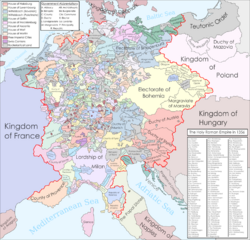
In the Dutch–Hanseatic War (1438–1441), a privateer war mostly waged by Wendish towns, the merchants of Amsterdam sought and eventually won free access to the Baltic. Although the blockade of the grain trade hurt Holland and Zeeland more than Hanseatic cities, it was against Prussian interest to maintain it.[36](p91)
The economic crises of the late 15th century did not spare the Hansa. Nevertheless, its eventual rivals emerged in the form of the territorial states, whether new or revived. New vehicles of credit were imported from Italy.[citation needed]
A general trend over the 15th century was that the Hanseatic hometowns increasingly introduced new statures into the kontors' legislation, especially after 1474. Only the Bergen kontor grew more independent in this period.[37](p136)
Frederick II, Elector of Brandenburg, tried to assert authority over the Hanseatic towns Berlin and Cölln in 1442 and blocked all towns of Brandenburg from participating in Hanseatic diets. For some but not all Brandenburg towns this was the end of their Hanseatic involvement. In 1488 John Cicero, Elector of Brandenburg did the same to Stendal and Salzwedel in the Altmark.[52](pp34–35)
In 1454, the year of the marriage of Elisabeth of Austria to King-Grand Duke Casimir IV Jagiellon of Poland-Lithuania, the towns of the Prussian Confederation rose up against the dominance of the Teutonic Order and asked Casimir IV for help. Gdańsk (Danzig), Thorn and Elbing became part of the Kingdom of Poland, (from 1466 to 1569 referred to as Royal Prussia, region of Poland) by the Second Peace of Thorn.
Poland in turn was heavily supported by the Holy Roman Empire through family connections and by military assistance under the Habsburgs. Kraków, then the capital of Poland, had a loose association with the Hansa.[53](p93) The lack of customs borders on the River Vistula after 1466 helped to gradually increase Polish grain exports, transported to the sea down the Vistula, from 10,000 short tons (9,100 t) per year, in the late 15th century, to over 200,000 short tons (180,000 t) in the 17th century.[54] The Hansa-dominated maritime grain trade made Poland one of the main areas of its activity, helping Danzig to become the Hansa's largest city. The Polish kings soon began to reduce the towns' political freedoms.[52](p36)
The Griffin dukes of Pomerania from the middle of the fifteenth century began constant conflicts to bring the Pomeranian Hanseatic towns under their control. This was not very successful at first, but Bogislav X subjugated Stettin and Köslin and harmed the economy and restricted the independence of many other towns.[52](p35)

A major economic advantage for the Hansa was its control of the shipbuilding market, mainly in Lübeck and Danzig. The League sold ships throughout Europe.[citation needed]
When Flanders and Holland became part of the Duchy of Burgundy, Burgund Dutch and Prussian cities increasingly excluded Lübeck from their grain trade in the 15th and 16th century. Burgund Dutch demand for Prussian and Livonian grain grew in the late 15th century. These trade interests differed from Wendish interests, threatening political unity, but it also showed a trade where the Hanseatic system was unpractical.[33](pp198, 215–216) Hollandish freight costs were much lower than those of the Hansa, and the Hansa were excluded as middlemen.[citation needed] After several naval wars between Burgundy and the Hanseatic fleets, Amsterdam gained the position of leading port for Polish and Baltic grain from the late 15th century onwards.[citation needed]
Nuremberg in Franconia developed an overland route to sell formerly Hansa-monopolised products from Frankfurt via Nuremberg and Leipzig to Poland and Russia, trading Flemish cloth and French wine in exchange for grain and furs from the east. The Hansa profited from the Nuremberg trade by allowing Nurembergers to settle in Hanseatic towns, which the Franconians exploited by taking over trade with Sweden as well. The Nuremberger merchant Albrecht Moldenhauer was influential in developing the trade with Sweden and Norway, and his sons Wolf Moldenhauer and Burghard Moldenhauer established themselves in Bergen and Stockholm, becoming leaders of the local Hanseatic activities.
King Edward IV of England reconfirmed the league's privileges in the Treaty of Utrecht despite the latent hostility, in part thanks to the significant financial contribution the League made to the Yorkist side during the Wars of the Roses of 1455–1487.[55](pp308–309) Tsar Ivan III of Russia closed the Hanseatic Kontor at Novgorod in 1494 and deported its merchants to Moscow, in an attempt to reduce Hanseatic influence on Russian trade.[56](p145) At the time only 49 traders were at the Peterhof.[57](p99) The fur trade was redirected to Leipzig, taking out the Hansards;[38](p54) while the Hanseatic trade with Russia moved to Riga, Reval and Pleskau.[57](p100) When the Peterhof reopened in 1514, Novgorod wasn't a trade hub any longer.[55](pp182, 312) In the same period the burghers of Bergen tried to develop an independent intermediate trade with the northern population, against the Hansards' obstruction.[41](p144) The very existence of the League and its privileges and monopolies created economic and social tensions that often crept over into rivalries between League members.
End of the Hansa
The development of the Transatlantic trade after the discovery of the Americas caused the remaining kontors' decline, especially in Bruges, because it centred on other ports. It also changed business practice to short-term contracts and made the Hanseatic model of privileged guaranteed trade outdated.[37](pp154)
The trends of local feudal lords asserting control over towns and suppressing their autonomy, and of foreign rulers repressing Hanseatic traders continued in the next century.
In the Swedish War of Liberation 1521–1523 the Hanseatic League was successful in opposition in an economic conflict it had over the trade, mining and metal industry in Bergslagen[58] (the main mining area of Sweden in the 16th century) with Jakob Fugger (early extremely rich industrialist in the mining and metal industry on the continent) and his unfriendly business take-over attempt. Fugger allied with his financially dependent pope Leo X, Maximilian I, Holy Roman Emperor and Christian II of Denmark/Norway. Both sides made huge costly investments in support of larger amounts of expensive hired mercenaries to win the war. After the war Gustav Vasa's Sweden and Frederick I's Denmark pursued independent policies and didn't support Lübeck's effort against Dutch trade.[43](p113)
However, Lübeck under Jürgen Wullenwever overextended in the Count's Feud in Scania and Denmark and lost influence in 1536 after Christian III's victory.[41](p144) Lübeck's attempts at forcing competitors out of the Sound eventually alienated even Gustav Vasa.[43](p113–114) Its influence in the Nordic countries began to decline.
The Hanseatic towns of Guelders were obstructed in the 1530s by Charles II, Duke of Guelders. The strict Catholic Charles objected to the Lutheranism, in his words "Lutheran heresy", of Lübeck and other north German cities. This frustrated but did not end the towns' Hanseatic trade and there was a small resurgence later.[59]
Later in the 16th century, Denmark-Norway took control of much of the Baltic Sea. Sweden had regained control over its own trade, the Kontor in Novgorod had closed, and the Kontor in Bruges had become effectively moribund because the Zwin inlet was closing up.[37](p132) Finally, the growing political authority of the German princes constrained the independence of the Hanse's towns.
The league attempted to deal with some of these issues: it created the post of syndic in 1556 and elected Heinrich Sudermann to the position, who worked to protect and extend the diplomatic agreements of the member towns. In 1557 and 1579 revised agreements spelled out the duties of towns and some progress was made. The Bruges Kontor moved to Antwerp in 1520[37](p140–154) and the Hansa attempted to pioneer new routes. However the league proved unable to prevent the growing mercantile competition.
In 1567, a Hanseatic League agreement reconfirmed previous obligations and rights of league members, such as common protection and defense against enemies.[60] The Prussian Quartier cities of Thorn, Elbing, Königsberg and Riga and Dorpat also signed. When pressed by the King of Poland–Lithuania, Danzig remained neutral and would not allow ships running for Poland into its territory. They had to anchor somewhere else, such as at Pautzke (Puck).
The Antwerp Kontor, moribund after the Fall of Antwerp, closed in 1593. In 1597 Queen Elizabeth of England expelled the League from London, and the Steelyard closed and sequestered in 1598. The Kontor was returned in 1606 under King James but it couldn't recover.[55](pp341–343) The Bergen Kontor continued until 1754; of all the Kontore, only its buildings, the Bryggen, survive.
Not all states tried to suppress their cities' former Hanseatic links; the Dutch Republic encouraged its eastern former members to maintain ties with the remaining Hanseatic League. The States-General relied on those cities in diplomacy at the time of the Kalmar War.[35](p123)
The Thirty Years War was destructive for the Hanseatic League and members suffered heavily from both the imperials, the Danes and the Swedes. At the beginning, Saxon and Wendish faced attacks because of the desire of Christian IV of Denmark to control the Elbe and Weser. Pomerania had a very strong population decline. Sweden took Bremen-Verden (excluding the city of Bremen), Swedish Pomerania (including Stralsund, Greifswald, Rostock) and Swedish Wismar, preventing their cities from participating in the League, and controlled the Oder, Weser and Elbe, and could levy tolls on their traffic.[43](pp114–116) The league became increasingly irrelevant despite its inclusion in the Peace of Westphalia.[32](p43)
In 1666, the Steelyard in London was burned down by the Great Fire of London. The Kontor-manager sent a letter to Lübeck appealing for immediate financial assistance for a reconstruction. Hamburg, Bremen, and Lübeck called for a Hanseatic Day in 1669. Only a few cities participated and those who came were very reluctant to contribute financially to the reconstruction. It was the last formal meeting, without any of the parties knowing it would be the last. This date is often taken in retrospect as the effective end date of the Hansa, but the Hansa was never formally disbanded. It simply disintegrated and petered out silently.[61](p192)[14](p2)
After disintegration
The Hanseatic League, however, lived on in the public mind. Leopold I even requested Lübeck to call a Tagfahrt to rally support for him against the Turks.[61](p192)
Lübeck, Hamburg and Bremen continued to attempt common diplomacy, although interests had already diverged by the Peace of Ryswick.[61](p192) Nonetheless, the Hanseatic Republics were able to jointly perform some diplomacy, such as a joint delegation to the United States in 1827, led by Vincent Rumpff; later the U.S. established a consulate to the Hanseatic and Free Cities from 1857 to 1862.[62] Britain maintained diplomats to the Hanseatic Cities until the unification of Germany in 1871. The three cities also had a common "Hanseatic" representation in Berlin until 1920.[61](p192)
Three kontors also remained as, often unused, Hanseatic property after the League's effective disbandment, as the Peterhof was already closed in the 16th century. Bryggen was sold to Norwegian owners in 1754. The Steelyard in London and the Oostershuis in Antwerp were long impossible to sell. The Steelyard was finally sold in 1852 and the Oostershuis, closed in 1593, was sold in 1862.[61](p192)[55](pp341–343)
Hamburg, Bremen, and Lübeck remained as the only members until the League's formal end in 1862, on the eve of the 1867 founding of the North German Confederation and the 1871 founding of the German Empire under Kaiser Wilhelm I. Despite its collapse, they still cherished the link to the Hanseatic League. Until German reunification, these three cities were the only ones that retained the words "Hanseatic City" in their official German names. Hamburg and Bremen continue to style themselves officially as "free Hanseatic cities", with Lübeck named "Hanseatic City". For Lübeck in particular, this anachronistic tie to a glorious past remained important in the 20th century. In 1937, the Nazi Party revoked its imperial immediacy through the Greater Hamburg Act.[63] Since 1990, 24 other German cities have adopted this title.[64]
Organization
The Hanseatic League was a complex and loose-jointed constellation of protagonists pursuing their own interests, which coincided in a shared program of economic domination in the Baltic region, and by no means a monolithic organization or a 'state within a state'.[65]:37–38 It gradually grew from a network of merchant guilds to develop a more formal association of cities and was never even formed into a legal person.[57](p91)
The members of the Hanseatic League were Low German speaking merchants, with the exception of Dinant, whose towns were where these merchants held citizenship. Not all towns with Low German merchant communities were members of the league (e.g., Emden, Memel (today Klaipėda), Viborg (today Vyborg) and Narva never joined). However, Hansards could also come from settlements without German town law—the premise for league membership was birth to German parents, subjection to German law, and a commercial education. The league served to advance and defend the common interests of its heterogeneous members: commercial ambitions such as enhancement of trade, and political ambitions such as ensuring maximum independence from the noble territorial rulers.[66]:10–11
Decisions and actions of the Hanseatic League were the result of a consensus-based procedure. If an issue arose, the league's members were invited to participate in a central meeting, the Tagfahrt (Hanseatic Diet, "meeting ride", sometimes also referred to as Hansetag), that some argue already happened around 1300[18](p59) but were formalised since 1358; some date the first diet to 1356.[36](pp66–67) The member communities then chose envoys (Ratssendeboten) to represent their local consensus on the issue at the Diet. Not every community sent an envoy; delegates were often entitled to represent a set of communities. Consensus-building on local and Tagfahrt levels followed the Low Saxon tradition of Einung, where consensus was defined as absence of protest: after a discussion, the proposals which gained sufficient support were dictated aloud to the scribe and passed as binding Rezess if the attendees did not object; those favouring alternative proposals unlikely to get sufficient support were obliged to remain silent during this procedure. If consensus could not be established on a certain issue, it was found instead in the appointment of a number of league members who were then empowered to work out a compromise.[66]:70–72
The Hanseatic League was characterised by legal pluralism and the diets could not issue laws. But the cities cooperated to achieve limited trade regulation, like measures against fraud, or worked together on a regional level. There was also interest in harmonising maritime law, a long series of ordinances on maritime law was issued in the 15th and 16th centuries. The most extensive maritime ordinance was the Ship Ordinance and Sea Law of 1614, but it's dubious that it was ever enforced.[67](pp31, 37–38)
Kontors
The Hanseatic Kontore, which operated like an early stock exchange,[68]:443–446 were settlements of Hansards and organised in the mid 14th century as private corporations that each had their own treasury, court, legislation and seal.They were probably established first to provide security, but also served to secure privileges and engage in diplomacy.[37](pp128–130, 134–135) The quality of goods was also examined at kontors, increasing the efficiency of trade, and the kontors served as bases to develop connections with local rulers and as sources of economic and political information.[57](p91)[lower-alpha 3] Most kontors were also physical locations containing several buildings, that were integrated and segregated from citylife to different degrees. The kontor of Bruges was an exception, it didn't acquire any buildings until the 15th century.[37](pp131–133) Like the guilds, the Kontore were usually led by Ältermänner ("eldermen", or English aldermen). The Stalhof, as a special case, had a Hanseatic and an English alderman. In Novgorod the aldermen were replaced by a hofknecht in the 15th century.[55](pp100–101) The kontors' statutes were read aloud to the present merchants once a year.[37](pp131–133)
In 1347 the Kontor of Bruges modified its statute to ensure an equal representation of the league's members. To that end, member communities from different regions were pooled into three circles (Drittel ("third [part]"): the Wendish and Saxon Drittel, the Westphalian and Prussian Drittel as well as the Gothlandian, Livonian and Swedish Drittel). The merchants from their respective Drittel would then each choose two aldermen and six members of the Eighteen Men's Council (Achtzehnmännerrat) to administer the Kontor for a set period of time.[57](p91, 101)[37](pp138–139)
In 1356, during a Hanseatic meeting in preparation of the first Tagfahrt, or one of the first, the league confirmed this statute. All trader settlements including the Kontors were subordinated to the Diet's decisions around this time, and their envoys also received the right to attend and speak at Diets but they lacked voting power.[57](p91)[lower-alpha 4]
Drittel
The league in general gradually adopted and institutionalized the division into Drittel (see table).[66]:62–63[69]:55[70][71](pp62–64)
| Drittel (1356–1554) | Regions | Chief city (Vorort) |
|---|---|---|
| Wendish-Saxon | Holstein, Saxony, Mecklenburg, Pomerania, Brandenburg | Lübeck |
| Westphalian-Prussian | Westphalia, Rhineland, Prussia | Dortmund, later Cologne |
| Gothlandian-Livonian-Swedish | Gotland, Livonia, Sweden | Visby, later Riga |
The Hansetag was the only central institution of the Hanseatic League. However, with the division into Drittel ("thirds"), the members of the respective subdivisions frequently held a Dritteltage ("Drittel meeting") to work out common positions which could then be presented at a Hansetag. On a more local level, league members also met, and while such regional meetings were never formalized into a Hanseatic institution, they gradually gained importance in the process of preparing and implementing a Diet's decisions.[72](pp55–57)
Quarters
From 1554, the division into Drittel was modified to reduce the circles' heterogeneity, to enhance the collaboration of the members on a regional level and thus to make the League's decision-making process more efficient.[73](p217) The number of circles rose to four, so they were called Quartiere (quarters):[69]
| Quartier (since 1554) | Chief city (Vorort) |
|---|---|
| Wendish and Pomeranian[74] | Lübeck[74] |
| Saxon, Thuringian and Brandenburg[74] | Brunswick,[74] Magdeburg[citation needed] |
| Prussia, Livonia and Sweden[74] – or East Baltic[75](pp47,120) | Danzig (now Gdańsk)[74] |
| Rhine, Westphalia and the Netherlands[74] | Cologne[74] |
This division was however not adopted by the Kontore, who, for their purposes (like Ältermänner elections), grouped the league members in different ways (e.g., the division adopted by the Stalhof in London in 1554 grouped the league members into Dritteln, whereby Lübeck merchants represented the Wendish, Pomeranian Saxon and several Westphalian towns, Cologne merchants represented the Cleves, Mark, Berg and Dutch towns, while Danzig merchants represented the Prussian and Livonian towns).[76](p38–92)
Hanseatic ships
A number of different types of ships was used in the Hanseatic League for transport over sea and inland waters.
The type that was the most used by the Hansa, and the most emblematic, was the cog. The cog was a multi-purpose clinker-built ship with carvel bottom, a stern rudder and a square rigged mast. Most cogs were privately owned merchant ships, but they were also used as warships. It was built in a variety of sizes and specifications and was used to navigate seas and rivers. They could be outfitted with castles starting from the thirteenth century. The cog was depicted on many seals and several coats of arms of Hanseatic cities, like Stralsund, Elbląg and Wismar. Several ship wrecks of cogs have been found. The most famous one is the well preserved Bremen cog.[39](p35–36) It could carry a cargo of about 125 tons.[77](p20) The hulk began to replace the cog by 1400 and cogs lost their dominance to them around 1450.[78](p264)
The hulk was a bulkier ship that could carry larger loads; Elbl estimates they could carry up to 500 tons by the 15th century. It could be clinker or carvel-built.[78](p264)[79](p64) No archeological evidence of a hulk has been found.
In 1464 Danzig acquired a French carvel ship through a legal dispute and renamed it the Peter von Danzig. It was 40 m long and had three masts, being one of the largest ships of its time. Danzig adopted carvel construction around 1470,[56](p44) other cities also shifted to carvel type starting from this time. An example is the Jesus of Lübeck, later sold to England for use as a warship and slave ship.[80]
The galleonlike carvel warship Adler von Lübeck was constructed by Lübeck for military use against Sweden during the Northern Seven Years' War (1563–70), launched in 1566, but was never put to military use after the Treaty of Stettin. It was the biggest ship of its day at 78 m long and had four masts, including a bonaventure mizzen. It served as a merchant ship until it was damaged in 1581 on a return voyage from Lisbon and broken up in 1588.[56](pp43–44)[81]
Lists of former Hanseatic cities
Hansa Proper
In the hidden table below, the names listed in the column labelled Quarter have been summarised as follows:
- "Wendish": Wendish and Pomeranian[74] (or just Wendish)[75]:120 quarter
- "Saxon": Saxon, Thuringian and Brandenburg[74] (or just Saxon)[75]:120 quarter
- "Baltic": Prussian, Livonian and Swedish[74] (or East Baltic)[75]:120 quarter
- "Westphalian": Rhine-Westphalian and Netherlands (including Flanders)[74] (or Rhineland)[75]:120 quarter
The remaining column headings are as follows:
- City – the city's name, with any variants
- Territory – the jurisdiction to which the city was subject at the time of the League
- Now – the modern nation-state in which the city is located
- From and Until – the dates at which the city joined and/or left the league
- Notes – additional details about the city
- Ref. – one or more references to works about the city
| Quarter | City | Territory | Now | From | Until | Notes | Template:Ref heading |
|---|---|---|---|---|---|---|---|
| Wendish | Lubeck Lübeck
|
Free imperial city Free City of Lübeck
|
Capital of the Hanseatic League, main town of the Wendish and Pomeranian Circle | ||||
| Wendish | Hamburg Hamburg
|
Free imperial city Free City of Hamburg
|
|||||
| Wendish | Luneburg Lüneburg
|
Brunswick-Luneburg Duchy of Brunswick-Lüneburg
|
|||||
| Wendish | Wismar Wismar
|
Mecklenburg Duchy of Mecklenburg
|
Joined the 10-year Rostock Peace Treaty (Rostocker Landfrieden) in 1283, which was the predecessor of the federation of Wendish towns (1293 onwards). | ||||
| Wendish | Rostock Rostock
|
Mecklenburg Duchy of Mecklenburg
|
Joined the 10-year Rostock Peace Treaty in 1283, which was the predecessor of the federation of Wendish towns (1293 onwards). | ||||
| Wendish | Stralsund Stralsund
|
Rugen Principality of Rügen
|
1293 | Rügen was a fief of the Danish crown to 1325. Stralsund joined the 10-year Rostock Peace Treaty in 1283, which was the predecessor of the federation of Wendish towns (1293 onwards). From 1339 to the 17th century, Stralsund was a member of the Vierstädtebund with Greifswald, Demmin and Anklam. | |||
| Wendish | Demmin Demmin
|
Pomerania Duchy of Pomerania
|
Joined the 10-year Rostock Peace Treaty in 1283, which was the predecessor of the federation of Wendish towns (1293 onwards). From 1339 to the 17th century, Demmin was a member of the Vierstädtebund with Stralsund, Greifswald and Anklam. | ||||
| Wendish | Greifswald Greifswald
|
Pomerania Duchy of Pomerania
|
Joined the 10-year Rostock Peace Treaty in 1283, which was the predecessor of the federation of Wendish towns (1293 onwards). From 1339 to the 17th century, Greifswald was a member of the Vierstädtebund with Stralsund, Demmin and Anklam. | ||||
| Wendish | Anklam Anklam
|
Pomerania Duchy of Pomerania
|
Joined the 10-year Rostock Peace Treaty in 1283, which was the predecessor of the federation of Wendish towns (1293 onwards). From 1339 to the 17th century, Anklam was a member of the Vierstädtebund with Stralsund, Greifswald and Demmin. | ||||
| Wendish | Stettin Stettin (Szczecin)
|
Pomerania Duchy of Pomerania
|
1278 | Joined the 10-year Rostock Peace Treaty in 1283, which was the predecessor of the federation of Wendish towns (1293 onwards); since the 14th century gradually adopted the role of a chief city for the Pomeranian Hanse towns to its east | |||
| Wendish | Pasewalk Pasewalk
|
Pomerania Duchy of Pomerania
|
|||||
| Wendish | Kolberg Kolberg (Kołobrzeg)
|
Pomerania Duchy of Pomerania
|
|||||
| Wendish | Rugenwalde File:POL Darłowo COA 1.svg Rügenwalde (Darłowo)
|
Pomerania Duchy of Pomerania
|
|||||
| Wendish | Stolp Stolp (Słupsk)
|
Pomerania Duchy of Pomerania
|
|||||
| Wendish | Stargard Stargard
|
Pomerania Duchy of Pomerania
|
|||||
| Baltic | Visby Visby
|
Sweden Kingdom of Sweden
|
1470 | In 1285 at Kalmar, the League agreed with Magnus III, King of Sweden, that Gotland be joined with Sweden.[citation needed] In 1470, Visby's status was rescinded by the League, with Lübeck razing the city's churches in May 1525. | |||
| Saxon | Braunschweig Braunschweig
|
Brunswick-Luneburg Duchy of Brunswick-Lüneburg
|
13th cent. | 17th cent. | Main town of the Saxon, Thuringian and Brandenburg Circle | ||
| Saxon | Bremen Bremen
|
Free imperial city Free City of Bremen
|
1260 | ||||
| Saxon | Magdeburg Magdeburg
|
Magdeburg Archbishopric of Magdeburg
|
13th cent. | Main town of the Saxon, Thuringian and Brandenburg Circle | |||
| Saxon | Goslar Goslar
|
Goslar Imperial City of Goslar
|
1267 | 1566 | Goslar was a fief of Saxony until 1280. | ||
| Saxon | Hanover Hanover
|
Brunswick-Luneburg Duchy of Brunswick-Lüneburg
|
|||||
| Saxon | Göttingen Göttingen
|
Brunswick-Luneburg Duchy of Brunswick-Lüneburg
|
|||||
| Saxon | Erfurt Erfurt
|
Mainz Archbishopric of Mainz
|
1430 | ||||
| Saxon | Stade Stade
|
Bremen Archbishopric of Bremen
|
|||||
| Saxon | Berlin Berlin
|
Brandenburg Margraviate of Brandenburg
|
1442 | Brandenburg was raised to an Electorate in 1356. Elector Frederick II caused all the Brandenburg cities to leave the League in 1442. | |||
| Saxon | Frankfurt Oder Frankfurt an der Oder
|
Brandenburg Margraviate of Brandenburg
|
1430 | 1442 | Elector Frederick II caused all the Brandenburg cities to leave the League in 1442. | ||
| Saxon | Salzwedel Salzwedel
|
Brandenburg Margraviate of Brandenburg
|
1263 | 1518 | In 1488 the Hanseatic cities of the Altmark region rebelled against a beer tax against Elector of Brandenburg John Cicero. They lost and were punished by being forced to leave the Hanseatic League. Salzwedel and Stendal managed to stay in the Hanseatic League until 1518. | ||
| Saxon | Uelzen Uelzen
|
Brunswick-Luneburg Duchy of Brunswick-Lüneburg
|
|||||
| Saxon | Stendal Stendal
|
Brandenburg Margraviate of Brandenburg
|
1358 | 1518 | In 1488 the Hanseatic cities of the Altmark region rebelled against a beer tax against Elector of Brandenburg John Cicero. They lost and were punished by being forced to leave the Hanseatic League. Salzwedel and Stendal managed to stay in the Hanseatic League until 1518. | ||
| Saxon | Hamelin Hamelin
|
||||||
| Baltic | Danzig Danzig (Gdańsk)
|
Teutonic Order Teutonic Order
|
1358 | Main town of the Prussian, Livonian and Swedish (or East Baltic) Circle. Danzig had been first a part of the Duchy of Pomerelia with a Kashubian and German population, then part of the State of the Teutonic Order from 1308 until 1457. After the Second Peace of Thorn (1466) Danzig became an autonomous city under the protection of the Polish Crown until the 18th century when it returned to Prussia. | |||
| Baltic | Elbing Elbing (Elbląg)
|
Teutonic Order Teutonic Order
|
1358 | Elbing had originally been part of the territory of the Old Prussians, until the 1230s when it became part of the State of the Teutonic Order. After the Second Peace of Thorn (1466), Royal Prussia, including Elbląg was part of the Kingdom of Poland. | |||
| Baltic | Thorn Thorn (Toruń)
|
Teutonic Order Teutonic Order
|
1280 | Toruń was part of the State of the Teutonic Order from 1233 until 1466. After the Second Peace of Thorn (1466), Royal Prussia, including Toruń, was part of the Kingdom of Poland. | |||
| Baltic | Krakow Kraków
|
Poland Kingdom of Poland
|
c. 1370 | c. 1500 | Kraków was the capital of the Kingdom of Poland, 1038–1596/1611. It adopted Magdeburg town law and 5000 Poles and 3500 Germans lived within the city proper in the 15th century; Poles steadily rose in the ranks of guild memberships reaching 41% of guild members in 1500. It was very loosely associated with Hansa, and paid no membership fees, nor sent representatives to League meetings. | ||
| Baltic | Breslau Breslau, (Wrocław)
|
Silesia Kingdom of Bohemia
|
1387 | 1474 | Breslau, a part of the Duchy of Breslau and the Kingdom of Bohemia, was only loosely connected to the League and paid no membership fees nor did its representatives take part in Hansa meetings | ||
| Baltic | Culm Culm (Chełmno)
|
Teutonic Order Teutonic Order
|
|||||
| Baltic | Konigsberg Königsberg (Kaliningrad)
|
Teutonic Order Teutonic Order
|
1340 | Königsberg was the capital of the Teutonic Order, it accepted the sovereignty of the Polish crown in 1466. It became Ducal Prussia in 1525 after secularisation, a German principality that was a fief of the Polish crown until gaining its independence in the 1660 Treaty of Oliva. The city was renamed Kaliningrad in 1946 after East Prussia was divided between the People's Republic of Poland and the Soviet Union at the Potsdam Conference. | |||
| Baltic | Riga Riga
|
Livonia Terra Mariana (Livonia)
|
1282 | During the Livonian War (1558–83), Riga became a Free imperial city until the 1581 Treaty of Drohiczyn ceded Livonia to the Polish–Lithuanian Commonwealth until the city was captured by Sweden in the Polish–Swedish War (1621–1625). | |||
| Baltic | Reval Reval (Tallinn)
|
Livonia Terra Mariana (Livonia)
|
1285 | On joining the Hanseatic League, Reval was a Danish fief, but was sold in 1346, with the rest of northern Estonia, to the Teutonic Order. In 1561, Reval became a dominion of Sweden. | |||
| Baltic | Dorpat Dorpat (Tartu)
|
Livonia Terra Mariana (Livonia)
|
1280s | The Bishopric of Dorpat had increasing autonomy within the Terra Mariana (Livonian confederation). With the Treaty of Drohiczyn in 1581, Dorpat fell under the rule of the Polish–Lithuanian Commonwealth until the city was captured by Sweden in the Polish–Swedish War (1621–1625). | |||
| Baltic | Fellin Fellin (Viljandi)
|
Livonia Terra Mariana (Livonia)
|
|||||
| Baltic | Pernau Pernau (Pärnu)
|
Livonia Terra Mariana (Livonia)
|
|||||
| Baltic | Wenden Wenden (Cēsis)
|
Livonia Terra Mariana (Livonia)
|
|||||
| Baltic | Kokenhusen Kokenhusen (Koknese)
|
Livonia Terra Mariana (Livonia)
|
|||||
| Baltic | Roop Roop (Straupe)
|
Livonia Terra Mariana (Livonia)
|
|||||
| Baltic | Windau Windau (Ventspils)
|
Livonia Terra Mariana (Livonia)
|
|||||
| Baltic | Haapsalu Haapsalu (Hapsal)
|
Livonia Terra Mariana (Livonia)
|
|||||
| Baltic | Lemsal Lemsal (Limbaži)
|
Livonia Terra Mariana (Livonia)
|
|||||
| Baltic | Wolmar Wolmar (Valmiera)
|
Livonia Terra Mariana (Livonia)
|
|||||
| Baltic | Goldingen Goldingen (Kuldīga)
|
Livonia Terra Mariana (Livonia)
|
|||||
| Westphalian | Cologne Cologne
|
Cologne Imperial City of Cologne
|
1669 | Main town of the Rhine-Westphalian and Netherlands Circle until after the Anglo-Hanseatic War (1470–74), when the city was prosecuted in 1475 with temporary trade sanctions (German: Verhanst) for some years for having supported England; Dortmund was made main town of the Circle. Cologne also was called "Electorate of Cologne" (German: Kurfürstentum Köln or Kurköln). In June 1669 the last Hanseday was held in the town of Lübeck by the last remaining Hanse members, amongst others Cologne. | |||
| Westphalian | Dortmund Dortmund
|
Dortmund Imperial City of Dortmund
|
After Cologne was excluded after the Anglo-Hanseatic War (1470–74), Dortmund was made the main town of the Rhine-Westphalian and Netherlands Circle. | ||||
| Westphalian | Dinant Dinant
|
||||||
| Westphalian | Deventer Deventer
|
Utrecht Bishopric of Utrecht
|
1500 | ||||
| Westphalian | Nijmegen Nijmegen
|
Guelders Jülich-Guelders
|
|||||
| Westphalian | Kampen Kampen
|
Utrecht Bishopric of Utrecht
|
1441 | ||||
| Westphalian | Zwolle Zwolle
|
Utrecht Utrecht
|
1294 | ||||
| Westphalian | Groningen Groningen
|
Friesland Friesland
|
|||||
| Westphalian | Roermond Roermond
|
Guelders Jülich-Guelders
|
|||||
| Westphalian | Arnhem Arnhem
|
Guelders Jülich-Guelders
|
|||||
| Bolsward Bolsward
|
Frisia | ||||||
| Stavoren Stavoren (Starum)
|
Frisia | [107]:398
| |||||
| Westphalian | Doesburg Doesburg
|
Guelders Jülich-Guelders
|
|||||
| Westphalian | Zutphen Zutphen
|
Guelders Jülich-Guelders
|
|||||
| Westphalian | Harderwijk Harderwijk
|
Guelders Jülich-Guelders
|
[35](pp114–115)
| ||||
| Westphalian | Venlo Venlo
|
Guelders Jülich-Guelders
|
[35](pp115)
| ||||
| Westphalian | Hattem Hattem
|
Guelders Jülich-Guelders
|
|||||
| Westphalian | Elburg Elburg
|
Guelders Jülich-Guelders
|
|||||
| Westphalian | Ommen Ommen
|
Utrecht Utrecht
|
[35](pp115)
| ||||
| Westphalian | Tiel Tiel
|
Utrecht Utrecht
|
[35](pp115)
| ||||
| Westphalian | Hasselt Hasselt
|
Utrecht Utrecht
|
|||||
| Westphalian | Oldenzaal Oldenzaal
|
Utrecht Utrecht
|
|||||
| Westphalian | Zaltbommel Zaltbommel
|
Guelders Jülich-Guelders
|
[35](pp115)
| ||||
| Westphalian | Munster Münster
|
Munster Prince-Bishopric of Münster
|
|||||
| Westphalian | Osnabruck Osnabrück
|
Osnabruck Prince-Bishopric of Osnabrück
|
12th cent. | ||||
| Westphalian | Wesel Wesel
|
||||||
| Westphalian | Soest Soest
|
Soest Imperial City of Soest
|
1609 | The city was a part of the Electorate of Cologne until acquiring its freedom in 1444–49, after which it aligned with the Duchy of Cleves. | |||
| Westphalian | Paderborn Paderborn
|
||||||
| Westphalian | Lemgo Lemgo
|
||||||
| Westphalian | Herford Herford
|
||||||
| Minden Minden
|
Kontore
The kontore were the major foreign trading posts of the League, not cities that were Hanseatic members, and are listed in the hidden table below.
| Quarter | City | Territory | Now | From | Until | Notes | Template:Ref heading |
|---|---|---|---|---|---|---|---|
| Kontor | Novgorod Novgorod: Peterhof
|
Novgorod Novgorod Republic
|
1500s | Novgorod was one of the principal Kontore of the League and the easternmost. In 1494, Ivan III, Grand Prince of Moscow, closed the Peterhof; it was reopened a few years later, but the League's Russian trade never recovered. | |||
| Kontor | Bergen Bergen: Bryggen
|
Norway Kingdom of Norway
|
1360 | 1775 | Bryggen was one of the principal Kontore of the League. It was razed by accidental fire in 1476. In 1560, administration of Bryggen was placed under Norwegian administration. | ||
| Kontor | Bruges Bruges: Hanzekantoor
|
Flanders County of Flanders
|
Bruges was one of the principal Kontore of the League until the 15th century, when the seaway to the city silted up; trade from Antwerp benefiting from Bruges's loss. | ||||
| Kontor | London London: Steelyard
|
England Kingdom of England
|
1303 | 1853 | The Steelyard was one of the principal Kontore of the League. King Edward I granted a Carta Mercatoria in 1303. The Steelyard was destroyed in 1469 and Edward IV exempted Cologne merchants, leading to the Anglo-Hanseatic War (1470–74). The Treaty of Utrecht, sealing the peace, led to the League purchasing the Steelyard outright in 1475, with Edward having renewed the League's privileges without insisting on reciprocal rights for English merchants in the Baltic. London merchants persuaded Elizabeth I to rescind the League's privileges on 13 January 1598; while the Steelyard was re-established by James I, the advantage never returned. Consulates continued however, providing communication during the Napoleonic Wars, and the Hanseatic interest was only sold in 1853. | ||
| Kontor | Antwerp Antwerp
|
Brabant Duchy of Brabant
|
Antwerp became a major Kontor of the League, particularly after the seaway to Bruges silted up in the 15th century, leading to its fortunes waning in Antwerp's favour, despite Antwerp's refusal to grant special privileges to the League's merchants. Between 1312 and 1406, Antwerp was a margraviate, independent of Brabant. |
Vitten
The vitten were significant foreign trading posts of the League in Scania, not cities that were Hanseatic members, they are argued by some to have been similar in status to the kontors,[37](pp157–158) and are listed in the hidden table below.
| Quarter | City | Territory | Now | From | Until | Notes | Template:Ref heading |
|---|---|---|---|---|---|---|---|
| Vitte | Malmo Malmö
|
Denmark Kingdom of Denmark
|
15th cent. | Skåne (Scania) was Danish until ceded to Sweden by the 1658 Treaty of Roskilde, during the Second Northern War. | |||
| Vitte | Falsterbo Falsterbo
|
Denmark Kingdom of Denmark
|
15th cent. | Skåne was Danish until ceded to Sweden by the 1658 Treaty of Roskilde, during the Second Northern War. |
Ports with Hansa trading posts
- Åhus[37](p159)
- Berwick-upon-Tweed
- Bishop's Lynn (King's Lynn)[82][105][110]:95[37](p158)[113]
- Boston[82][88][105][110]:95[37](p158)
- Bordeaux[105][37](p159)
- Bourgneuf[37](p159)
- Bristol[82]
- Copenhagen[37](p159)
- Damme[82]
- Frankfurt[37](p160)
- Ghent[37](p159)
- Hull (Kingston upon Hull)[82][105]
- Ipswich[82][105][114][37](p158)
- Kalundborg[37](p159)
- Kaunas[37](p159)[70][82][105]
- Landskrona[37](p159)
- La Rochelle[37](p159)
- Leith[82][105]
- Lisbon[115][37](p159)
- Nantes[105][37](p159)
- Narva[70][105]
- Næstved[37](p159)
- Newcastle[82][105][37](p158)
- Norwich[37](p158)
- Nuremberg[37](p160)
- Oslo[37](p159)
- Pleskau (Pskov)[37](pp159–160)[82][105]
- Polotsk[82][105][37](p159)
- Rønne[37](p159)
- Scarborough[37](p158)
- Yarmouth (Great Yarmouth)[82][105][37](p158)
- Sluis[37](p159)
- Smolensk[37](p159)
- Tønsberg[37](p159)
- Venice[37](p160)
- Vilnius[70][105][37](p159)
- Vitebsk[37](p159)
- York[82][105]
- Ystad[37](p159)
Other cities with a Hansa community
- Aberdeen[116]
- Åbo (Turku)[105]
- Avaldsnes[88][112]
- Brae[105]
- Grindavík[105]
- Grundarfjörður[105]
- Gunnister[105][112][117]
- Hafnarfjörður[88][105][118]
- Harlingen[citation needed]
- Haroldswick[105]
- Hildesheim[71][85][86]
- Hindeloopen (Hylpen)[107]:397[119]
- Kalmar[84][120]
- Krambatangi[88][112]
- Kumbaravogur[121]
- Leghorn[122]:98
- Lunna Wick[105]
- Messina[123]
- Naples[123]
- Nordhausen[71][84]
- Nyborg[105]
- Nyköping[84]
- Scalloway
- Stockholm[82][84][37](p160)
- Tórshavn[88][105]
- Trondheim[112]
- Tver
- Walk (Valka)[70]
- Weißenstein (Paide)[70]
- Wesenberg (Rakvere)[70]
Legacy
Historiography
Academic historiography of the Hanseatic League is considered to begin with Georg Sartorius, who started writing his first work in 1795 and founded the liberal historiographical tradition about the Hanseatic League. The German conservative nationalist historiographical tradition was first published with F.W. Barthold's Geschichte der Deutschen Hansa of 1853/1854. The conservative view was associated with Little German ideology and came to predominate from the 1850s until the end of the First World War. Hanseatic history was used to justify a stronger German navy and conservative historians drew a link between the League and the rise of Prussia as the leading German state. This climate deeply influenced the historiography of the Baltic trade for long.[61](pp192–194)[33](pp203–204)
Issues of social, cultural and economic history became more important in German research after the First World War. But a leading historian like Fritz Rörig also promoted a National Socialist perspective. After the Second World War the conservative nationalist view was forsaken, allowing exchanges between German, Swedish and Norwegian historians on the Hanseatic League's role in Sweden and Norway. Views on the League were very negative in those countries, as they still are in Denmark. Philippe Dollinger's book The German Hansa became the standard work in the 1960s. From that time on, the dominant perspective has been of loosely aligned trading network bridging several northern European markets. Marxist historians in the GDR were split on whether the League was a "late feudal" or "proto-capitalist" phenomenon.[61](pp197–200)
There are two museums in Europe dedicated specifically to the history of the Hanseatic League: the European Hansemuseum in Lübeck and the Hanseatic Museum and Schøtstuene in Bergen.
Popular views
From the 19th century Hanseatic history was often used to promote a national cause in Germany. German liberals built a fictional literature around Jürgen Wullenwever, that contained fierce anti-Danish sentiment. Hanseatic subjects were used to propagate nation building, colonialism, fleet building and warfare, and the League was presented as a bringer of culture and pioneer of German expansion.[61](pp195–196)
The preoccupation with a strong navy motivated German painters since the 19th century to paint supposedly Hanseatic ships. They used the traditions of maritime paintings and, not wanting Hanseatic ships to look unimpressive, ignored historical evidence to fictionalise cogs into tall two- or three-masted ships. The depictions were widely reproduced, like on plates of Norddeutscher Lloyd. This misleading artistic tradition influenced public perception for the entire 20th century.[61](pp196–197)
In the late 19th century, a social-critical view developed, where opponents of the League like the likedeelers were presented as heroes and liberators from economic oppression. This was very popular from the end of the First World War into the 30s, and lives on in the Störtebeker Festival on Rügen, founded as the Rügenfestspiele by the GDR.[61](pp196)
From the late 1970s, the Europeanness and cooperation of the Hanseatic League has come to prominence in popular culture. It also is associated with innovation, entrepreneurism and internationalness in economic circles.[61](pp199–203) In this way it often used for tourism, city branding and commercial marketing.[35](p109) The League's unique governance structure has been identified as a precursor to the supranational model of the European Union.[124]
Modern transnational organisations named after the Hanseatic League
Union of Cities THE HANSA
In 1979 Zwolle invited over 40 cities from West Germany, the Netherlands, Sweden and Norway with historic links to the Hanseatic League to sign the recesses of 1669, at Zwolle's 750 year city rights' anniversary in August of the next year.[125] In 1980, those cities established a "new Hanse" in Zwolle, named Städtebund Die Hanse (Union of Cities THE HANSA) in German and reinstituted the Hanseatic diets. This league is open to all former Hanseatic League members and cities that share a Hanseatic heritage.[126]
In 2012 the city league had 187 members. This includes twelve Russian cities, most notably Novgorod, and 21 Polish cities. No Danish cities have joined the Union of Cities.[61](pp199–200) The "new Hanse" fosters business links, tourism and cultural exchange.[126]
The headquarters of the New Hansa is in Lübeck, Germany. The current President of the Hanseatic League of New Time is Jan Lindenau, Mayor of Lübeck.[126]
Dutch cities including Groningen, Deventer, Kampen, Zutphen and Zwolle, and a number of German cities including Bremen, Buxtehude, Demmin, Greifswald, Hamburg, Lübeck, Lüneburg, Rostock, Salzwedel, Stade, Stendal, Stralsund, Uelzen and Wismar now call themselves Hanse cities (the German cities' car license plates are prefixed H, e.g. –HB– for "Hansestadt Bremen").
Each year one of the member cities of the New Hansa hosts the Hanseatic Days of New Time international festival.
In 2006, King's Lynn became the first English member of the union of cities.[127] It was joined by Hull in 2012 and Boston in 2016.[128]
New Hanseatic League
The New Hanseatic League was established in February 2018 by finance ministers from Denmark , Estonia, Finland , Ireland, Latvia, Lithuania, the Netherlands and Sweden through the signing of a foundational document which set out the countries' "shared views and values in the discussion on the architecture of the EMU".[129]
Other entities named after the Hanseatic League
The legacy of the Hansa is remembered today in several names: the German airline Lufthansa (lit. "Air Hansa"); F.C. Hansa Rostock, nickamed the Kogge or Hansa-Kogge; Hansa-Park, one of the biggest theme parks in Germany; Hanze University of Applied Sciences in Groningen, Netherlands; Hanze oil production platform, Netherlands; the Hansa Brewery in Bergen and the Hanse Sail in Rostock; Hanseatic Trade Center in Hamburg; DDG Hansa, which was a major German shipping company from 1881 until its bankruptcy and takeover by Hapag-Lloyd in 1980; the district of New Hanza City in Riga, Latvia; and Hansabank in Estonia, which has been rebranded into Swedbank.
Historical maps
Carta marina of the Baltic Sea region (1539)
In popular culture
- In the Patrician series of trading simulation video games, the player assumes the role of a merchant in any of several cities of the Hanseatic League.[130]
- In the Saga of Seven Suns series of space opera novels by American writer Kevin J. Anderson, the human race has colonized multiple planets in the Spiral Arm, most of which are governed by the powerful Terran Hanseatic League (Hansa).[131]
- Hansa Teutonica is a German board game designed by Andreas Steding and published by Argentum Verlag in 2009.
- In the Metro franchise of post-apocalyptic novels and video games, a trading alliance of stations called The Commonwealth of the Stations of the Ring Line is also known as the Hanseatic League, usually shortened to Hansa or Hanza.
See also
- Baltic maritime trade (c. 1400–1800)
- Bay Fleet
- Brick Gothic
- Company of Merchant Adventurers of London
- Hanseatic Cross
- Hanseatic Days of New Time
- Hanseatic flags
- Hanseatic Museum and Schøtstuene
- History of Bremen (City)
- Maritime republics
- Peasants' Republic
- Schiffskinder
- Thalassocracy
Explanatory footnotes
- ↑ /ˌhænsiˈætɪk/. Template:Lang-gml, Düdesche Hanse, Hansa; Modern German: Deutsche Hanse; Dutch: Hanze; Latin: Hansa Teutonica.[3]
- ↑ Een opvalled euvel betrof de gewoonte dat gezanten, die voor hen nadelige afspraken niet konden accepteren, vroegtijdig de Hanzedag verlieten. Op deze wijze hoopten zij niet in de notulen, de zogenaamde Hanzerecessen, te worden opgenomen. Het verschafte de stadsbesturen vervolgens de mogelijkheid de daarin opgenomen besluiten niet te ratificeren. [...] Opvallend is dat de Hanzedag, en ook Lübeck en de Wendische steden, niet in staat waren dit fenomeen te sanctioneren en zelfs een gedoogpolitiek ontstond. Terwijl veel historici hierin een essentiële zwakte van de Hanze zien, vat Pichierri dit op als een teken van flexibiliteit. [...] Al met al zijn dit enkele kenmerken van een organisatiestructuur die bij sociologen als een netwerk met losse bindingen te boek staat. De verbindingen tussen de verschillende leden van een dergelijke netwerk waren niet star noch daadwerkelijk verplichtend. [...] Het gebrek aan duurzame samenhand vloeide voort uit de grote autonomie van de steden zoals deze besloten lag in het zogenaamde Einungsrecht. [...] Juist doordat de Hanzevergadering vast bleef houden aan het uitgangspunt dat de gemeenschappelijke wil van alle steden afzonderlijk gerespecteerd moest worden, kon een besluit alleen op grond van algemene instemming genomen worden. [...] Volgens de principes van het Einungsrecht was echter geen enkele stad gedwongen zich aan de wil of aan de besluiten van een woordvoerder, in dit geval de Algemene Hanzedag, te onderwerpen. Aan het einde van de besluitvormingsketen was de instemming van de stedelijke gemeenschap doorslaggevend, ongeacht wat er op hogere niveaus was afgesproken. Het kwam derhalve zeer regelmatig voor dat besluiten die raadszendbode vanuit een minderheidspositie stilzwijgend moesten aanvaarden, achteraf door hun stadsbesturen werden afgewezen. A notable shortcoming concerned the custom that envoys, who could not accept arrangements that were disadvantageous for them, left the Hanseatic Day prematurely. In this way they hoped not to be included in the minutes, the so-called Hanseatic recesses. It then provided the city authorities with the option of not ratifying the decrees contained therein. [...] It is striking that the Hanseatic Day, and also Lübeck and the Wendish cities, were unable to sanction this phenomenon and even a policy of condoning arose. While many historians see this as an essential weakness of the Hanseatic League, Pichierri sees this as a sign of flexibility. [...] All in all, these are some characteristics of an organizational structure that sociologists regard as a network with loose connections. The connections between the various members of such a network were neither rigid nor actually binding. [...] The lack of sustainable cohesion arose from the great autonomy of the cities as it was implied in the so-called Einungsrecht. [...] Precisely because the Hanseatic Assembly continued to adhere to the principle that the common will of all individual cities had to be respected, a decision could only be taken on the basis of general consent. [...] According to the principles of Einungsrecht, however, no city was forced to submit to the will or to the decisions of a spokesman, in this case the General Hansedag. At the end of the decision-making chain, the agreement of the urban community was decisive, regardless of what was agreed at higher levels. It therefore happened very regularly that decisions that council messengers had to accept tacitly from a minority position were subsequently rejected by their city councils (Brand 2010).
- ↑ Door de Kantoren werden er duurzame relaties met de machthebbers ter plaatse opgebouwd. Daaarnaast waren ze ook een onmisbare bron van informatie voor de Hanzesteden over de lokale politiek en handel. Bovendien waren de Kantoren plaatsen waar er controle was op de kwaliteit van goederen in de hanzeatische handel. Dit bevorderde de efficiëntie van deze handel. [...] Het midden van de veertiende eeuw wordt voor Brugge en Bergen als scharnierpunt in het ontstaan van de Kantoren gezien omdat ze toen een vastere organisatie en duidelijke regelgeving kregen. [...] Niettemin waren de Kantoren, in tegenstelling tot de Hanze als geheel, wel degelijk rechtsperonen. Als gevolg daarvan voerden ze eigen zegels, hadden ze een eigen administratie, een gemeenschappelijke kas en de machtsmiddelen om het correct naleven van de regels af te dwingen. The Kontors built lasting relationships with local ruler. In addition, they were also an indispensable source of information for the Hanseatic cities about local politics and trade. Moreover, the Kontors were places where the quality of goods in the Hanseatic trade was monitored. This promoted the efficiency of this trade. [...] The middle of the fourteenth century is seen as a pivotal point in the emergence of the Kontors for Bruges and Bergen, because they were then given a more permanent organization and clear regulations. [...] Nevertheless, unlike the Hanseatic League as a whole, the Kontors were indeed legal persons. As a result, they had their own seals, had their own administration, a common treasury and the means to enforce proper compliance with the rules (Wubs-Mrozewicz 2010).
- ↑ Rond dezelfde tijd werden ook alle nederzettingen formeel ondergeschikt aan de beslissingen van de Hanzedag. Hun vertegenwoordigers hadden sindsdien het recht om de Hanzevergaderingen bij te wonen en voor de belangen van de Kantoren en hun kooplieden te pleiten. Ze hadden er echter geen stemrecht. Around the same time, all settlements were also formally subordinated to the decisions of the Hanseatic League. Since then their representatives had the right to attend the Hanse meetings and to advocate for the interests of the Offices and their merchants. However, they had no voting rights (Wubs-Mrozewicz 2010).
References
- ↑ "Die Verdrängung der mittelniederdeutschen durch die neuhochdeutsche Schriftsprache" (in de). Handbuch zur niederdeutschen Sprach – und Literaturwissenschaft. Berlin: Erich Schmidt Verlag. 1983. pp. 119–181. ISBN 978-3-503-01645-7. https://books.google.com/books?id=QGavEQHPCqgC&pg=PA119.
- ↑ Blank, Angelika (1 June 2008). "Die Hanse - Bündnis mit Tradition" (in de). wendland-net.de. https://wendland-net.de/post/hanse-buendnis-geschichte.
- ↑ "Synonym-Details zu 'Deutsche Hanse · Düdesche Hanse · Hansa Teutonica (lat.)". openthesaurus. https://www.openthesaurus.de/synonyme/edit/23690.
- ↑ "THE HANSA: Union with a long tradition King's Lynn". Lübeck: Union of Cities THE HANSA. 2023. https://www.hanse.org/en/hanse/kings-lynn.
- ↑ "Hanseatic King's Lynn: King's Lynn was Great Britain's first member of Die Hanse (The Hanse)". King's Lynn: Borough Council of King's Lynn & West Norfolk. 2023. https://www.visitwestnorfolk.com/destinations/kings-lynn/history/hanseatic/.
- ↑ Bischof, Stefanie. "The Hanseatic story: 400 years of exciting past". Lübeck: Hanseatic Office – Town Hall. https://www.hanse.org/en/hanse-historic/the-history-of-the-hanseatic-league/.
- ↑ 7.0 7.1 7.2 7.3 7.4 Hibbert, Arthur Boyd. "Hanseatic League | Definition, History, & Facts". https://www.britannica.com/topic/Hanseatic-League.
- ↑ Seebold, Elmar (2008) (in de). Chronologisches Wörterbuch des deutschen Wortschatzes, Vol. 2 Der Wortschatz des 9. Jahrhunderts. Walter de Gruyter. p. 388. ISBN 978-3-11-020502-2.
- ↑ Delvaux de Fenffe, Gregor (11 March 2018). "Hanse" (in de). Planet Wissen. https://www.planet-wissen.de/geschichte/mittelalter/hanse/index.html.
- ↑ Köbler, Gerhard (3 August 2014). "Mittelniederdeutsches Wörterbuch: H." (in de). Innsbruck: Gerhard Köbler. https://www.koeblergerhard.de/mnd/mnd_h.html.
- ↑ Weststrate, Job (2010). "Handel en transport over land en rivieren". in Brand, Hanno; Egge, Knol (in nl). Koggen, kooplieden en kantoren: de Hanze, een praktisch netwerk (hardcover) (1st ed.). Hilversum & Groningen: Uitgeverij Verloren & Groninger Museum. ISBN 978-90-8704-165-6. https://books.google.com/books?id=T5e68QReeykC&pg=PA145.
- ↑ Martin, Janet (1975). "Les Uškujniki de Novgorod: Marchands ou Pirates?" (in fr). Cahiers du Monde Russe et Soviétique (The Hague: Mouton & Co) 16: 5–18.
- ↑ Smith, Jillian R. (May 2010). Hanseatic Cogs and Baltic Trade: Interrelations Between Trade, Technology and Ecology (Thesis). Lincoln, NE: University of Nebraska at Lincoln. pp. 14–25. Retrieved 1 July 2019.
- ↑ 14.0 14.1 Schulte Beerbühl, Margrit (2012). "Networks of the Hanseatic League". European History Online (Mainz: Institute of European History). http://nbn-resolving.de/urn:nbn:de:0159-2011121210.
- ↑ Ewert, Ulf Christian; Sunder, Marco (2 September 2011). "Trading Networks, Monopoly and Economic Development in Medieval Northern Europe: an Agent-Based Simulation of Early Hanseatic Trade". 9th European Historical Economics Society Conference, Dublin, Ireland. Oakville, Ontario, Canada: Medievalists.net. https://www.medievalists.net/2014/02/trading-networks-monopoly-economic-development-medieval-northern-europe-agent-based-simulation-early-hanseatic-trade/. Retrieved 18 January 2023.
- ↑ Rotz, Rhiman A. (1977). "The Lubeck Uprising of 1408 and the Decline of the Hanseatic League". Proceedings of the American Philosophical Society 121 (1): 1–45. ISSN 0003-049X.
- ↑ Sartorius Von Waltershausen, Georg-Friedrich-Christoph (1830). Lappenberg, J. M.. ed (in de). Urkundliche Geschichte des Ursprunges der deutschen Hanse. 2. Hamburg: Friedrich Perthes. p. 94. https://books.google.com/books?id=aUSNiCkcb9YC.
- ↑ 18.00 18.01 18.02 18.03 18.04 18.05 18.06 18.07 18.08 18.09 18.10 18.11 18.12 18.13 18.14 Hammel-Kiesow, Rolf (2015). "The Early Hansas". in Harreld, Donald J. (in en). A Companion to the Hanseatic League. Brill's Companions to European History. Leiden, Boston: Brill. pp. 15–63. ISBN 978-90-04-28288-9.
- ↑ Braunmüller, Kurt (2005). "135. Language contacts in the Late Middle Ages and in Early Modern Times". in Bandle, Oskar; Braunmüller, Kurt; Jahr, Ernst Håkon et al.. The Nordic Languages: An International Handbook of the History of the North Germanic Languages (hardcover). 2 (1st ed.). Berlin, New York: Walter de Gruyter. ISBN 978-3-1101-7149-5. https://books.google.com/books?id=6b7WwBC5tRAC.
- ↑ Laurén, Christer (2005). "208. Special languages and their social and functional dimensions 1: Socially dependent varieties". in Bandle, Oskar; Braunmüller, Kurt; Jahr, Ernst Håkon et al.. The Nordic Languages: An International Handbook of the History of the North Germanic Languages (hardcover). 2 (1st ed.). Berlin, New York: Walter de Gruyter. ISBN 978-3-1101-7149-5. https://books.google.com/books?id=6b7WwBC5tRAC.
- ↑ Soosaar, Sven-Erik (2013). "The Origins of Stems of Standard Estonian – A Statistical Overview". Trames. Journal of the Humanities and Social Sciences (TRAMES) 17 (3): 273. doi:10.3176/tr.2013.3.04. https://www.kirj.ee/public/trames_pdf/2013/issue_3/Trames-2013-3-273-300.pdf. Retrieved 24 February 2023.
- ↑ Siliņa-Piņķe, Renāte (August 2019). "Spuren des Mittelniederdeutschen in den lettischen Eigennamen" (in de). Zeitschrift für Dialektologie und Linguistik (Franz Steiner Verlag) 86 (2): 229–243. doi:10.25162/ZDL-2019-0009. https://biblioscout.net/article/10.25162/ZDL-2019-0009. Retrieved 24 February 2023.
- ↑ "The Chronicle of the Hanseatic League". http://www.european-heritage.org/germany/m%C3%BCnster/hanseatic/cronicle-hanse.
- ↑ Pletneva, Olga (20 December 2006). "Ancient Rus: Trade and Crafts". Moscow: Garant-InfoCentre. http://www.russia-ic.com/business_law/trade_and_crafts/331/#.XJHN2yMd_IU.
- ↑ Wubs-Mrozewicz, Justyna (2008). Traders, ties and tensions: the interactions of Lübeckers, Overijsslers and Hollanders in Late Medieval Bergen. Hilversum: Uitgeverij Verloren. p. 111. ISBN 978-90-8704-041-3. https://books.google.com/books?id=VrCgvOuV5U0C.
- ↑ Lloyd, T. H. (1991). "The winning of the Hanse franchises, 1157–1361". England and the German Hanse, 1157–1611: A Study of Their Trade and Commercial Diplomacy (revised ed.). Cambridge: Cambridge University Press (published 2002). p. 15. ISBN 978-0-521-52214-4. https://books.google.com/books?id=PYYdGhgzGHYC. Retrieved 2 February 2020. "[A] grant of about 1157 [...] conferred perpetual protection upon the homines et cives Colonienses. As long as they paid established dues they were to be treated as the king's own men and no fresh charges would be levied on them without their consent. By this time they had some form of corporate organisation with a headquarters in London [...]."
- ↑ Huffman, Joseph P. (13 November 2003). Family, Commerce, and Religion in London and Cologne: Anglo-German Emigrants, c. 1000 – c. 1300 (revised ed.). Cambridge University Press (published 2003). ISBN 978-0-521-52193-2. https://books.google.com/books?id=aFZ9IKWhqxEC.
- ↑ Korpiola, Mia (2018). "18. Customary Law and the Influence of the ius commune in high and late Medieval east Central Europe: III 'Germanisation' of East Central European Law: Towns as conduits of Reception". in Pihlajamäki, Heikki; Dubber, Markus D.; Godfrey, Mark. The Oxford Handbook of European Legal History. Oxford University Press.
- ↑ Feldbrugge, Ferdinand J.M. (2017). A History of Russian Law: From Ancient Times to the Council Code (Ulozhenie) of Tsar Aleksei Mikhailovich of 1649. Brill. p. 230. ISBN 978-90-0435-214-8.
- ↑ Sedlar, Jean W. (1994). East Central Europe in the Middle Ages, 1000-1500. University of Washington Press. p. 328. ISBN 978-0-295-97290-9.
- ↑ Frankot, Edda (2012). Of Laws of Ships and Shipmen: Medieval Maritime Law and its Practice in Urban Northern Europe. Edinburgh University Press. p. 108. ISBN 978-0-7486-6807-6.
- ↑ 32.00 32.01 32.02 32.03 32.04 32.05 32.06 32.07 32.08 32.09 32.10 Brand, Hanno (2010). "De bestuurlijke slagkracht van de 'Stedenhanze'". in Brand, Hanno; Egge, Knol (in nl). Koggen, kooplieden en kantoren: de Hanze, een praktisch netwerk (hardcover) (1st ed.). Hilversum & Groningen: Uitgeverij Verloren & Groninger Museum. ISBN 978-90-8704-165-6. https://books.google.com/books?id=T5e68QReeykC&pg=PA36.
- ↑ 33.0 33.1 33.2 33.3 Jahnke, Carsten (2015). "The Baltic Trade". in Harreld, Donald J. (in en). A Companion to the Hanseatic League. Brill's Companions to European History. Leiden, Boston: Brill. pp. 194–240. ISBN 978-90-04-28288-9.
- ↑ Braudel, Fernand (17 January 2002). Civilization and Capitalism, 15th–18th century (softcover). 3: The Perspective of the World. London: Phoenix Press. ISBN 978-1-84212-289-1.
- ↑ 35.00 35.01 35.02 35.03 35.04 35.05 35.06 35.07 35.08 35.09 35.10 35.11 35.12 35.13 35.14 35.15 35.16 35.17 35.18 35.19 Looper, Bert (2010). "De Nederlandse Hanzesteden: scharnieren in de Europese economie 1250–1550". in Brand, Hanno; Egge, Knol (in nl). Koggen, kooplieden en kantoren: de Hanze, een praktisch netwerk (hardcover) (1st ed.). Hilversum & Groningen: Uitgeverij Verloren & Groninger Museum. ISBN 978-90-8704-165-6. https://books.google.com/books?id=T5e68QReeykC&pg=PA108.
- ↑ 36.00 36.01 36.02 36.03 36.04 36.05 36.06 36.07 36.08 36.09 36.10 36.11 36.12 36.13 Sarnowsky, Jürgen (2015). "The 'Golden Age' of the Hanseatic League". in Harreld, Donald J. (in en). A Companion to the Hanseatic League. Brill's Companions to European History. Leiden, Boston: Brill. pp. 64–100. ISBN 978-90-04-28288-9.
- ↑ 37.00 37.01 37.02 37.03 37.04 37.05 37.06 37.07 37.08 37.09 37.10 37.11 37.12 37.13 37.14 37.15 37.16 37.17 37.18 37.19 37.20 37.21 37.22 37.23 37.24 37.25 37.26 37.27 37.28 37.29 37.30 37.31 37.32 37.33 37.34 37.35 37.36 37.37 37.38 37.39 37.40 37.41 37.42 37.43 37.44 37.45 37.46 Burkhardt, Mike (2015). "Kontors and Outposts". in Harreld, Donald J. (in en). A Companion to the Hanseatic League. Brill's Companions to European History. Leiden, Boston: Brill. pp. 127–161. ISBN 978-90-0428-288-9.
- ↑ 38.0 38.1 Jahnke, Carsten (2010). "7. De Hanze en de Europese economie in the middeleeuwen [The Hanseatic League and the European economy in the Middle Ages"]. in Brand, Hanno; Egge, Knol (in nl). Koggen, kooplieden en kantoren: de Hanze, een praktisch netwerk (hardcover) (1st ed.). Hilversum & Groningen: Uitgeverij Verloren & Groninger Museum. ISBN 978-90-8704-165-6. https://books.google.com/books?id=T5e68QReeykC&pg=PA45.
- ↑ 39.0 39.1 Heidrink, Ingo (2012). "The Business of Shipping: An Historical Perspective". in Talley, Wayne K. (in en). The Blackwell Companion to Maritime Economics (hardcover) (1st ed.). Blackwell Publishing Ltd, John Wiley & Sons. ISBN 978-1-4443-3024-3. https://books.google.com/books?id=I_Uu4_VRDXUC&pg=PA35.
- ↑ Montgomery, John (2016). Upwave: City Dynamics and the Coming Capitalist Revival (hardcover) (reprint ed.). Abingdon-on-Thames, New York: Routledge. ISBN 978-1-317-00409-7. https://books.google.com/books?id=4MKXCwAAQBAJ&pg=PA72.
- ↑ 41.0 41.1 41.2 Hansen, Lars Ivar (2020). "The Trading Networks of the High North during the Sixteenth Century". in Berg, Sigrun Høgetveit; Bergesen, Rognald Heiseldal; Kristiansen, Roald Ernst (in English). The Protracted Reformation in the North. Walter de Gruyter. ISBN 9783110686210. https://books.google.com/books?id=Fkn2DwAAQBAJ&pg=PA144.
- ↑ Weststrate, Job (2010). "Handel en transport over land en rivieren". in Brand, Hanno; Egge, Knol (in nl). Koggen, kooplieden en kantoren: de Hanze, een praktisch netwerk (hardcover) (1st ed.). Hilversum & Groningen: Uitgeverij Verloren & Groninger Museum. ISBN 978-90-8704-165-6. https://books.google.com/books?id=T5e68QReeykC&pg=PA145.
- ↑ 43.0 43.1 43.2 43.3 North, Michael (2015). "The Hanseatic League in the Early Modern Period". in Harreld, Donald J. (in en). A Companion to the Hanseatic League. Brill's Companions to European History. Leiden, Boston: Brill. pp. 101–124. ISBN 978-90-0428-288-9.
- ↑ 44.0 44.1 Henn, Volker (2010). "Het ontstaan van de Hanze [The coming into being of the Hanseatic League"]. in Brand, Hanno; Egge, Knol (in nl). Koggen, kooplieden en kantoren: de Hanze, een praktisch netwerk (hardcover) (1st ed.). Hilversum & Groningen: Uitgeverij Verloren & Groninger Museum. ISBN 978-90-8704-165-6. https://books.google.com/books?id=T5e68QReeykC&pg=PA19.
- ↑ McKenna, Amy (2013). Denmark, Finland, and Sweden. Britanncia Educational Publishing. p. 186. ISBN 9781615309955. https://books.google.com/books?id=af-cAAAAQBAJ&pg=PA186.
- ↑ Ebelt, Thomas (2018). Lighthouses of Europe. Bloomsbury Publishing. p. 35. ISBN 9781472958754. https://books.google.com/books?id=sZNyDwAAQBAJ&pg=PA35.
- ↑ Stevenson, D. Alan (2013). The World's Lighthouses: From Ancient Times to 1820. Courier Corporation. ISBN 9780486157085. https://books.google.com/books?id=9fO7AQAAQBAJ&pg=PA24.
- ↑ Hansen, Mogens Herman, ed (2000). "Imperial and Free Towns of the Holy Roman Empire City States in Pre-Modern Germany?". A Comparative Study of Thirty City-State Cultures. Københavns universitet, Polis centret. Copenhagen: Copenhagen Polis Centre & C.A. Reitzels Forlag. p. 305. ISBN 978-8-7787-6177-4.
- ↑ Pulsiano, Phillip; Wolf, Kirsten (2019). Medieval Scandinavia: An Encyclopedia (softcover) (1st reprinted ed.). London: Taylor & Francis. ISBN 978-1-138-06302-0.
- ↑ Stearns, Peter N; Langer, William Leonard (2001). The Encyclopedia of World History: Ancient, Medieval, and Modern, Chronologically Arranged. Boston: Houghton Mifflin Harcourt. ISBN 978-0-395-65237-4. https://archive.org/details/encyclopediaworl00stea.
- ↑ MacKay, Angus; Ditchburn, David (1997). "Late Medieval Scandinavia: Unity and Disunity". Atlas of Medieval Europe. London & New York: Routledge. ISBN 978-0-415-12231-3. https://archive.org/details/atlasofmedievale0000unse/page/n7/mode/2up.
- ↑ 52.0 52.1 52.2 Carsten, F. L. (1985). "The Origins of the Junkers" (in en). Essays in German History. A&C Black. ISBN 978-1-4411-3272-7. https://books.google.com/books?id=uoaxAwAAQBAJ&pg=PA34.
- ↑ 53.0 53.1 Blumówna, Helena et al. (1965). Dąbrowski, Jan. ed (in pl). Kraków jego dzieje i sztuka: Praca zbiorowa (hardcover) (1st ed.). Warsaw: Arkady. https://catalog.lib.uchicago.edu/vufind/Record/1907431/Details#.
- ↑ Davies, Norman (1982). God's playground. A history of Poland, Volume 1: The Origins to 1795. Oxford University Press. ISBN 978-0-19-925339-5.
- ↑ 55.0 55.1 55.2 55.3 55.4 55.5 Dollinger, Philippe (2000). The German Hansa. London & New York: Routledge. ISBN 978-0-415-19073-2. https://books.google.com/books?id=jbompf7OyYwC&pg=PA341. Retrieved 30 April 2011.
- ↑ 56.0 56.1 56.2 Meier, Dirk (2009). Seafarers, Merchants and Pirates in the Middle ages (softcover) (Illustrated ed.). Martlesham, Suffolk: Boydell & Brewer. ISBN 978-1-84383-5-127.
- ↑ 57.0 57.1 57.2 57.3 57.4 57.5 57.6 Wubs-Mrozewicz, Justyna (2010). "De Kantoren van de Hanze: Bergen, Brugge, Londen en Nowgorod". in Brand, Hanno; Egge, Knol (in nl). Koggen, kooplieden en kantoren: de Hanze, een praktisch netwerk (hardcover) (1st ed.). Hilversum & Groningen: Uitgeverij Verloren & Groninger Museum. ISBN 978-90-8704-165-6. https://books.google.com/books?id=T5e68QReeykC&pg=PA91.
- ↑ Skantze, Margareta (2019) (in sv). Där brast ett ädelt hjärta: Kung Kristian II och hans värld. Lyckeby: Arakne Förlag AB. ISBN 978-91-9786-813-6.
- ↑ Benders, Jeroen (2010). "De stad Groningen en de Hanze tot het eind van de zestiende eeuw". in Brand, Hanno; Egge, Knol (in nl). Koggen, kooplieden en kantoren: de Hanze, een praktisch netwerk (hardcover) (1st ed.). Hilversum & Groningen: Uitgeverij Verloren & Groninger Museum. p. 184. ISBN 978-90-8704-165-6. https://books.google.com/books?id=T5e68QReeykC&pg=PA184.
- ↑ "Agreement of the Hanseatic League at Lübeck, 1557". Baltic Connections. http://www.balticconnections.net/views/exhibition/detail.cfm?mode=language&ID=18CEDA3F-D929-4A8E-E777F313AC7EB8E4.
- ↑ 61.00 61.01 61.02 61.03 61.04 61.05 61.06 61.07 61.08 61.09 61.10 61.11 Hammel-Kiesow, Rolf (2010). "Hoe de Hanze verdween en op de drempel van de 20e naar de 21e eeuw weer opleeft". in Brand, Hanno; Knol, Egge (in nl). Koggen, kooplieden en kantoren: de Hanze, een praktisch netwerk (hardcover) (1st ed.). Hilversum & Groningen: Uitgeverij Verloren & Groninger Museum. ISBN 978-90-8704-165-6. https://books.google.com/books?id=T5e68QReeykC&pg=PA191.
- ↑ "Hanseatic Republics* – Countries – Office of the Historian". https://history.state.gov/countries/hanseatic-republics.
- ↑ Seegers, Lu (2021). "Hanseaten und das Hanseatische im 20. Jahrhundert". in Historische Kommission für Niedersachsen und Bremen. Niedersächsisches Jahrbuch für Landesgeschichte. 92 (2020). Wallstein Verlag. p. 189. ISBN 9783835345102.
- ↑ "Alle politisch selbständigen Gemeinden mit ausgewählten Merkmalen am 30.06.2022 (2. Quartal 2022)" (in de). https://www.destatis.de/DE/Themen/Laender-Regionen/Regionales/Gemeindeverzeichnis/Administrativ/Archiv/GVAuszugQ/AuszugGV2QAktuell.html.
- ↑ Jahnke, Carsten (2012). Wubs-Mrozewicz, Justyna; Jenks, Stuart. eds. The Hanse in Medieval and Early Modern Europe. Leiden: Brill Academic Publishers. ISBN 978-90-0421-252-7.
- ↑ 66.0 66.1 66.2 66.3 Hammel-Kiesow, Rolf (2008) (in de). Die Hanse. Munich: C H Beck. ISBN 978-3-406-58352-0.
- ↑ Boestad, Tobias (2021). "Legitimizing interurban cooperation in the Middle Ages: the legal system of the Hanse". in Aust, Helmut P.; Marcenko, Miha; Nijman, Janne E.. Research Handbook on International Law and Cities. Edward Elgar Publishing. ISBN 9781788973281. https://books.google.com/books?id=MXg8EAAAQBAJ&pg=PA37.
- ↑ Northrup, Cynthia Clark, ed (2015). "Hanseatic League". Encyclopedia of World Trade: From Ancient Times to the Present. 2 (Reprint ed.). London and New York: Routledge. ISBN 978-0-7656-8058-7. https://books.google.com/books?isbn=1317471539. Retrieved 19 February 2018. "To facilitate trade in foreign countries, the Hansa established counters (Kontore) [...]. [...] The counters operated as the equivalent of an early stock exchange."
- ↑ 69.0 69.1 Pfeiffer, Hermannus (2009) (in de). Seemacht Deutschland. Die Hanse, Kaiser Wilhelm II. und der neue Maritime Komplex. Berlin: Ch. Links Verlag. ISBN 978-3-86153-513-3.
- ↑ 70.00 70.01 70.02 70.03 70.04 70.05 70.06 70.07 70.08 70.09 70.10 70.11 70.12 70.13 70.14 70.15 70.16 70.17 70.18 Mills, Jennifer (May 1998). "The Hanseatic League in the Eastern Baltic". Encyclopedia of Baltic History (group research project). Seattle, WA: University of Washington. http://depts.washington.edu/baltic/papers/hansa.html.
- ↑ 71.00 71.01 71.02 71.03 71.04 71.05 71.06 71.07 71.08 71.09 71.10 71.11 71.12 71.13 71.14 71.15 71.16 71.17 71.18 71.19 71.20 71.21 71.22 71.23 71.24 71.25 71.26 71.27 71.28 71.29 71.30 71.31 71.32 71.33 71.34 71.35 71.36 71.37 71.38 71.39 71.40 71.41 71.42 71.43 71.44 71.45 71.46 71.47 Falke, Dr Johannes (1863) (in de). Die Hansa als deutsche See- und Handelsmacht. Berlin: F Henschel. https://books.google.com/books?id=01NAAAAAcAAJ&pg=PA62.
- ↑ Distler, Eva-Marie (2006) (in de). Städtebünde im deutschen Spätmittelalter. Eine rechtshistorische Untersuchung zu Begriff, Verfassung und Funktion. Frankfurt: Vittorio Klostermann. ISBN 978-34-6504001-9.
- ↑ Fritze, Konrad et al. (1985) (in de). Die Geschichte der Hanse. Berlin: Das Europäische Buch. ISBN 978-3-8843-6142-9.
- ↑ 74.00 74.01 74.02 74.03 74.04 74.05 74.06 74.07 74.08 74.09 74.10 74.11 74.12 74.13 74.14 74.15 74.16 74.17 Natkiel, Richard; Preston, Antony (1989). Atlas of Maritime History. New York: Smithmark Publishing. p. 33. ISBN 978-0-8317-0485-8. https://archive.org/details/atlasofmaritimeh0000natk/page/33.
- ↑ 75.00 75.01 75.02 75.03 75.04 75.05 75.06 75.07 75.08 75.09 75.10 75.11 75.12 75.13 75.14 Keating, Michael (2004). Regions and regionalism in Europe. Cheltenham: Edward Elgar Publishing. ISBN 978-0-8317-0485-8. https://books.google.com/books?id=6meikazgxksC&pg=PA47.
- ↑ Reibstein, Ernst (1956). "Das Völkerrecht der deutschen Hanse" (in de). Zeitschrift für ausländisches öffentliches Recht und Völkerrecht (ZaöRV) (Heidelberg: Max-Planck-Institut für ausländisches öffentliches Recht und Völkerrecht) 17 (1). ISSN 0044-2348. http://www.zaoerv.de/17_1956_57/17_1956_1_a_38_92.pdf. Retrieved 30 April 2010.
- ↑ Baker, William A. (2013). "The Technical Importance of Shipwreck Archaeology". in Babits, Lawrence E.; Tilburg, van, Hans. Maritime Archaeology: A Reader of Substantive and Theoretical Contributions. Springer. ISBN 9781489900845. https://books.google.com/books?id=UzjoBwAAQBAJ&pg=PA20.
- ↑ 78.0 78.1 Elbl, Martin Malcolm (2020). "Hulk". in Friedman, John Block; Figg, Kristen Mossler. Trade, Travel, and Exploration in the Middle Ages: An Encyclopedia. Routledge. ISBN 9781135590949. https://books.google.com/books?id=-OmCfNI_SxAC&pg=PA264.
- ↑ Martin, C. (1990). "Hulk". in GALLAGHER, P.; CRUICKSHANK, D.W.. God's Obvious Design: Papers for the Spanish Armada Symposium, Sligo, 1988. Tamesis Books. ISBN 9781855660007. https://books.google.com/books?id=5FPK5cjimbUC&pg=PA62.
- ↑ Paine, Lincoln P. (2000). "Jesus of Lübeck". Warships of the World to 1900. Houghton Mifflin Harcourt. pp. 86–87. ISBN 9780395984147. https://books.google.com/books?id=Xh7CSxFeK-IC&pg=PA86.
- ↑ Kuipers, Jan J.B. (2020). De Hanze: Kooplui, koningen, steden & staten. Walburg Pers, Amsterdam University Press. ISBN 9789462495609. https://books.google.com/books?id=BCYGEAAAQBAJ.
- ↑ 82.00 82.01 82.02 82.03 82.04 82.05 82.06 82.07 82.08 82.09 82.10 82.11 82.12 82.13 82.14 82.15 82.16 82.17 82.18 82.19 82.20 82.21 82.22 82.23 82.24 82.25 82.26 82.27 82.28 82.29 82.30 82.31 82.32 82.33 82.34 82.35 82.36 82.37 82.38 82.39 82.40 82.41 82.42 82.43 82.44 82.45 82.46 82.47 82.48 82.49 82.50 82.51 82.52 82.53 82.54 Jotischky, Andrew; Caroline Hull (2005). The Penguin Historical Atlas of the Medieval World. Penguin Books. pp. 122–23. ISBN 978-0-14-101449-4. https://archive.org/details/penguinhistorica0000joti.
- ↑ 83.00 83.01 83.02 83.03 83.04 83.05 83.06 83.07 83.08 83.09 83.10 83.11 83.12 83.13 83.14 83.15 83.16 83.17 83.18 83.19 Holborn, Hajo (1982). A History of Modern Germany: The Reformation. Princeton University Press. pp. [1] 32, 74, 80–82. ISBN 0-691-00795-0. https://archive.org/details/historyofmoderng00hajo/page/32.
- ↑ 84.00 84.01 84.02 84.03 84.04 84.05 84.06 84.07 84.08 84.09 84.10 84.11 84.12 84.13 84.14 84.15 84.16 84.17 84.18 84.19 84.20 84.21 84.22 84.23 84.24 84.25 84.26 84.27 84.28 84.29 84.30 84.31 84.32 84.33 84.34 84.35 84.36 84.37 84.38 84.39 84.40 84.41 84.42 84.43 84.44 84.45 84.46 84.47 84.48 84.49 84.50 84.51 84.52 84.53 84.54 84.55 84.56 84.57 84.58 84.59 84.60 Dollinger, Philippe (2000). The German Hansa. Stanford University Press. pp. ix–x. ISBN 0-8047-0742-1. https://archive.org/details/germanhansa0000doll. Retrieved 15 May 2011.
- ↑ 85.00 85.01 85.02 85.03 85.04 85.05 85.06 85.07 85.08 85.09 85.10 85.11 85.12 85.13 85.14 85.15 85.16 85.17 85.18 85.19 85.20 85.21 85.22 85.23 85.24 85.25 85.26 85.27 85.28 85.29 85.30 85.31 Barthold, Dr Friedrich Wilhelm (1862). Geschichte der Deutschen Hanse. Leizig: TD Weigel. pp. 35 and 496–97.
- ↑ 86.00 86.01 86.02 86.03 86.04 86.05 86.06 86.07 86.08 86.09 86.10 86.11 86.12 86.13 86.14 86.15 86.16 86.17 86.18 86.19 86.20 86.21 86.22 86.23 86.24 86.25 86.26 86.27 86.28 86.29 86.30 86.31 86.32 86.33 86.34 86.35 86.36 86.37 86.38 86.39 86.40 Schäfer, D (2010). Die deutsche Hanse. Reprint-Verlag-Leipzig. pp. 37. ISBN 978-3-8262-1933-7.
- ↑ 87.0 87.1 87.2 87.3 87.4 87.5 87.6 Wernicke, Horst (2007). "Die Hansestädte an der Oder". in Schlögel, Karl; Halicka, Beata (in de). Oder-Odra. Blicke auf einen europäischen Strom. Lang. pp. 137–48; here p. 142. ISBN 978-3-631-56149-2.
- ↑ 88.00 88.01 88.02 88.03 88.04 88.05 88.06 88.07 88.08 88.09 88.10 88.11 88.12 88.13 Mehler, Natascha (2009). "The Perception and Interpretation of Hanseatic Material Culture in the North Atlantic: Problems and Suggestions". Journal of the North Atlantic (Special Volume 1: Archaeologies of the Early Modern North Atlantic): 89–108. http://histarch.univie.ac.at/fileadmin/user_upload/ag_histarch/PDF-Dateien/Mehler/Mehler_2009_JONA.pdf.
- ↑ "Stralsund". Encyclopædia Britannica. 2011. https://www.britannica.com/EBchecked/topic/567988/Stralsund. Retrieved 28 December 2011.
- ↑ 90.0 90.1 90.2 90.3 90.4 90.5 Buchholz, Werner (1999) (in de). Pommern. Siedler. p. 120. ISBN 3-88680-272-8.
- ↑ 91.0 91.1 91.2 91.3 Bedford, Neil (2008). Poland. Lonely Planet. pp. 403, 436, 452 and 476. ISBN 978-1-74104-479-9.
- ↑ "Varför ruinerades Visby" (in sv). Goteinfo.com. http://www.guteinfo.com/?id=2337.
- ↑ "Göttingen". Encyclopædia Britannica. https://www.britannica.com/EBchecked/topic/239864/Gottingen. Retrieved 2 May 2011.
- ↑ Westholm, Gun. Hanseatic Sites, Routes and Monuments: A Traveler's Guide to the Past and Present. Uppsala: Gotland Centre for Baltic Studies, 1994.
- ↑ Alma Mater. Kraków: Jagiellonian University. 2008. p. 6.
- ↑ Carter, Francis W. (1994). Trade and urban development in Poland. An economic geography of Cracow, from its origins to 1795, Volume 20. Cambridge studies in historical geography. Cambridge University Press. pp. 70–71, 100–02. ISBN 0-521-41239-0.
- ↑ Jelicz, Antonina (1966). Życie codzienne w średniowiecznym Krakowie: wiek XIII–XV. Państwowy Instytut Wydawniczy.
- ↑ Gilewska-Dubis, Janina (2000). Życie codzienne mieszczan wrocławskich w dobie średniowiecza. Wydawnictwo Dolnośląskie. p. 160.
- ↑ Buśko, Cezary; Włodzimierz Suleja; Teresa Kulak (2001). Historia Wrocławia: Od pradziejów do końca czasów habsburskich. Wydawnictwo Dolnośląskie. p. 152.
- ↑ 100.0 100.1 Turnbull, Stephen R (2004). Crusader castles of the Teutonic Knights: The stone castles of Latvia and Estonia 1185–1560. Osprey Publishing. pp. 20, 60. ISBN 978-1-84176-712-3.
- ↑ 101.0 101.1 101.2 101.3 101.4 101.5 101.6 101.7 101.8 Murray, Alan V. (2017). The North-Eastern Frontiers of Medieval Europe: The Expansion of Latin Christendom in the Baltic Lands. Taylor & Francis. ISBN 9781351884839. https://books.google.com/books?id=KgokDwAAQBAJ.
- ↑ "History of Koknese". Koknese official website. 10 January 2011. http://www.koknese.lv/?s=4&l=eng.
- ↑ "Collector Coin Koknese". National Bank of Latvia. http://www.bank.lv/en/money/collector-coin-koknese.
- ↑ Könnecke, Jochen; Vladislav Rubzov (2005). Lettland. DuMont Reiseverlag. pp. 23, 26–7, 161. ISBN 978-3-7701-6386-1.
- ↑ 105.00 105.01 105.02 105.03 105.04 105.05 105.06 105.07 105.08 105.09 105.10 105.11 105.12 105.13 105.14 105.15 105.16 105.17 105.18 105.19 105.20 105.21 105.22 105.23 105.24 105.25 105.26 105.27 105.28 105.29 105.30 105.31 105.32 Mehler, Natascha (2011). "Hansefahrer im hohen Norden". epoc (2): 16–25, particularly 20 and 21. http://histarch.univie.ac.at/fileadmin/user_upload/ag_histarch/PDF-Dateien/Mehler/Mehler_2011a.pdf.
- ↑ 106.0 106.1 106.2 106.3 106.4 106.5 106.6 106.7 ver Berkmoes, Ryan; Karla Zimmerman (2010). The Netherlands. Lonely Planet. p. [https://books.google.com/books?id=MkAw1f_iSEwC&pg=PA255 255]. ISBN 978-1-74104-925-1. https://archive.org/details/isbn_9781741049251/page/255.
- ↑ 107.0 107.1 107.2 107.3 107.4 107.5 107.6 107.7 107.8 107.9 McDonald, George (2009). Frommer's Belgium, Holland & Luxembourg, 11th Edition. Frommers. pp. [2] 134, 176, 397, 432–38. ISBN 978-0-470-38227-1. https://archive.org/details/frommersbelgiumh00geor/page/134.
- ↑ Merriam-Webster, Inc (1997). Merriam-Webster's geographical dictionary. Merriam-Webster, Inc. pp. [https://books.google.com/books?id=Co_VIPIJerIC&pg=PA74 74–75]. ISBN 978-0-87779-546-9. https://archive.org/details/merriamwebstersg1998merr/page/74.
- ↑ Miruß, Alexander (1838). Das See-Recht und die Fluß-Schifffahrt nach den Preußischen Gesetzen. Leipzig: JC Hinrichsschen Buchhandlung. p. 17. https://books.google.com/books?id=RXM7AAAAcAAJ&pg=PA17. Retrieved 2 May 2011.
- ↑ 110.0 110.1 110.2 110.3 Ward, Adolphus William. Collected Papers Historical, Literary, Travel and Miscellaneous. pp. 95, 391.
- ↑ 111.0 111.1
 This article incorporates text from a publication now in the public domain: Chisholm, Hugh, ed (1911). "Hanseatic League". Encyclopædia Britannica (11th ed.). Cambridge University Press.
This article incorporates text from a publication now in the public domain: Chisholm, Hugh, ed (1911). "Hanseatic League". Encyclopædia Britannica (11th ed.). Cambridge University Press.
- ↑ 112.0 112.1 112.2 112.3 112.4 Mehler, Natascha (April 2009). "HANSA: The Hanseatic Expansion in the North Atlantic". University of Vienna. http://histarch.univie.ac.at/dr-natascha-mehler-ma/projects/hansa-the-hanseatic-expansion-in-the-north-atlantic/.
- ↑ Conybeare, John (1985). "Trade Wars: A Comparative Study of Anglo-Hanse, Franco-Italian, and Hawley-Smoot Conflicts". World Politics 38 (1): 147–172. doi:10.2307/2010354.
- ↑ Grimwade, Patricia (2019). Ipswich: A Hanseatic Port. Ipswich: Ipswich Maritime Trust.
- ↑ Pohle, Jürgen (December 2010). "O estabelecimento dos mercadores-banqueiros alemães em Lisboa no início do século XVI". Universidade Atlântica (Lisbon). http://repositorio-cientifico.uatlantica.pt/jspui/bitstream/10884/615/1/RepC%20-%20Comunica%C3%A7%C3%A3o%20%C2%ABO%20estabelecimento%20dos%20mercadores-banqueiros%20alem%C3%A3es%C2%BB.pdf.
- ↑ Mitchell, Alex. "The Old Burghs Of Aberdeen". Aberdeen Civic Society. http://aberdeencivicsociety.org.uk/whats-new/the-old-burghs-of-aberdeen/.
- ↑ Gardiner, Mark; Natascha Mehler (2010). "The Hanseatic trading site at Gunnister Voe, Shetland". Post-Medieval Archaeology 44 (2): 347–49. http://histarch.univie.ac.at/fileadmin/user_upload/ag_histarch/PDF-Dateien/Mehler/Gardiner_Mehler_2010.pdf.
- ↑ Bjarnadóttir, Kristín (2006) (PDF), Mathematical Education in Iceland in Historical Context, Roskilde University, http://diggy.ruc.dk:8080/retrieve/9181/license.txt, retrieved 2 May 2011
- ↑ Wild, Albert (1862). Die Niederlande: ihre Vergangenheit und Gegenwart, Volume 2. Wigand. pp. 250.
- ↑ Dollinger, Philippe (2000). The German Hansa. Routledge. pp. 128, 352. ISBN 978-0-415-19073-2.
- ↑ Mehler, Natascha (October 2010). "The Operation of International Trade in Iceland and Shetland (c. 1400–1700)". University of Vienna. http://histarch.univie.ac.at/dr-natascha-mehler-ma/projekte/oitis-the-operation-of-international-trade-in-iceland-and-shetland-ca-1400-1700/.
- ↑ Walford, Cornelius (1881). "An Outline History of the Hanseatic League, More Particularly in Its Bearings upon English Commerce". Transactions of the Royal Historical Society (Transactions of the Royal Historical Society. Vol. 9 (1881), pp. 82–136) 9: 82–136. doi:10.2307/3677937. https://zenodo.org/record/2491599. "The following cities were also connected with the League, but did not have representation in the Diet, nor responsibility: (...) Leghorn, Lisbon, London, Marseilles, Messina,Naples (...)".
- ↑ 123.0 123.1 "Cultus.hk". http://www.cultus.hk/hist/readingsBaltic/History%20of%20the%20Hanseatic%20League.pdf.
- ↑ Morris, Chris. "Hanseatic League | The first European Union?". https://bbc.co.uk/news/extra/A2MFANtn3Z/hanseatic_league.
- ↑ Lelsz, Jac. (1979-12-22). "Hanze-reünie in feestvierend Zwolle" (in Dutch). Trouw. https://resolver.kb.nl/resolve?urn=ABCDDD:010825142:mpeg21:p017.
- ↑ 126.0 126.1 126.2 "City League The HANSE". http://www.hanse.org/en/the_hansa/.
- ↑ "King's Lynn Hanse Festival 2009". Borough Council of King's Lynn and West Norfolk. http://www.west-norfolk.gov.uk/Default.aspx?page=24618.
- ↑ Paul Richards (introduction) Six Essays in Hanseatic History 128 pages, plates and maps, Poppyland Publishing, Cromer, 2017. ISBN:9781909796331.
- ↑ Suutre, Siiri (6 March 2018). "Shared views and values on the architecture of the EMU". Estonian Ministry of Finance. (PDF at "Read more here"). https://www.rahandusministeerium.ee/en/news/shared-views-and-values-architecture-emu.
- ↑ Bett, Richard (2011-01-22). "Patrician IV Review" (in en-US). PC Gamer. https://www.pcgamer.com/patrician-iv-review/. Retrieved 2020-10-18.
- ↑ "Fiction Book Review: Hidden Empire: The Saga of Seven Suns Book 1". July 1, 2002. http://www.publishersweekly.com/978-0-446-52862-7.
Further reading
- Brand, Hanno (2006). Baltic Sea Trade: Baltic Connections. Hanse Research Center. http://www.balticconnections.net/index.cfm. Retrieved 30 May 2015.
- Colvin, Ian D. (1915). The Germans in England 1066–1598. The National Review.
- Dollinger, P (2000). The German Hansa. Routledge. pp. 341–43. ISBN 978-0-415-19073-2. https://books.google.com/books?id=jbompf7OyYwC&pg=PA342.
- Gade, John A. (1951). The Hanseatic Control of Norwegian Commerce During the Middle Ages. E.J. Brill.
- Halliday, Stephen. "The First Common Market?" History Today 59 (2009): 31–37.
- Harreld, Donald J. A companion to the Hanseatic League (Brill, 2015).
- Israel, I. Jonathan (1995). The Dutch Republic: Its Rise, Greatness and Fall, 1477–1806. Oxford University Press.
- Magnusson, Lars (2000). An Economic History of Sweden. Routledge.
- Meier, Dirk (2009). Seafarers, Merchants and Pirates in the Middle Ages. Boydell Press. ISBN 978-1-84383-5-127.
- Nash, Elizabeth Gee (1929). The Hansa: Its History and Romance. ISBN 1-56619-867-4.
- Nedkvinte, Arnved (2013). The German Hansa and Bergen 1100–1600. Böhlau Verlag. ISBN 9783412216825.
- Schulte Beerbühl, Margrit (2012). Networks of the Hanseatic League. Mainz: Institute of European History. http://nbn-resolving.de/urn:nbn:de:0159-2011121210. Retrieved 24 January 2012.
- Thompson, James Westfall (1931). Economic and Social History of Europe in the Later Middle Ages (1300–1530). pp. 146–79. https://archive.org/details/in.ernet.dli.2015.55855.
- Wubs-Mrozewicz, Justyna, and Jenks, Stuart eds. The Hanse in Medieval and Early Modern Europe (Leiden: Koninklijke Brill NV, 2013)
- Zimmern, Helen (1889). The Hansa Towns (The Story of the Nations series). T. Fisher Unwin.
Historiography
- Cowan, Alexander. "Hanseatic League: Oxford Bibliographies Online Research Guide" (Oxford University Press, 2010) online
- Harrison, Gordon. "The Hanseatic League in Historical Interpretation." The Historian 33 (1971): 385–97. doi:10.1111/j.1540-6563.1971.tb01514.x.
- Szepesi, Istvan. "Reflecting the Nation: The Historiography of Hanseatic Institutions." Waterloo Historical Review 7 (2015). online
External links
- 29th International Hansa Days in Novgorod
- 30th International Hansa Days 2010 in Parnu-Estonia
- Chronology of the Hanseatic League
- Hanseatic Cities in the Netherlands
- Hanseatic League Historical Re-enactors
- Hanseatic Towns Network
- Hanseatic League related sources in the German Wikisource
- Colchester: a Hanseatic port – Gresham
- The Lost Port of Sutton: Maritime trade
 KSF
KSF
